

MOBIS-COVID19/07
Results as of 18/05/2020
A Project of IVT, ETH Zurich and WWZ, University of Basel
This work is licensed under Creative Commons 
Contact: Joseph Molloy (joseph.molloy@ivt.baug.ethz.ch)
Previous and future reports can be found at: https://ivtmobis.ethz.ch/mobis/covid19/en
- 1 News
- 2 Introduction
- 3 First key points
- 4 Risk perception
- 5 Average daily distance
- 6 Active days
- 7 Change in kilometers travelled by transport mode
- 8 Change in kilometers travelled by:
- 9 Reduction in kilometers travelled by canton
- 10 Trip duration by transport mode and gender
- 11 Average trip length by transport mode (km)
- 12 Activity space and daily travel radius
- 13 Hourly counts
- 14 Activity types and zoning
- 15 Participation
- 16 Differences in the distributions
1 News
18 May:
- First report after the relaxation of lockdown measures on May 11th.
- The 2019 Baseline period has been shortened to only include September and October - This mostly affects the cycling numbers.
11 May:
- New graph of activity space and daily radius. - link
4 May:
- New chart from online survey with participants on risk perception. - link
- Key points summary and formatting adjustments.
27 April:
- New chart on the change in activity type by land zoning.
20 April:
- Mobile participants per day.
- Non-mobile participants are now included in the activity-space numbers in addition to a new table on median weekly activity spaces.
- New graphs, including average trip distance by mode.
- Formatting improvements and other small corrections.
13 April:
- Earlier weeks have been grouped and colored grey in certain graphs.
2 Introduction
On March 16, 2020, 3700 participants who completed the MOBIS study between September 2019 and January 2020 were invited to reinstall the GPS Logger and Travel Diary App ‘Catch-My-Day’, developed by MotionTag, to record their mobility behaviour during the period of special measures implemented to control the spread of the Corona Virus. The first 4 weeks of mobility data from the original MOBIS Study is taken for each participant as a baseline against which to compare current mobility patterns. These 4 weeks start place anywhere between 1st September and 15th November, depending on the participant. Only trips in Switzerland are currently considered, although data on cross border travel is available.
The following figure shows the number of registered and tracking participants per day. A running panel of around 250 participants were already tracking before the sample was reinvited. This allows results for the weeks before the MOBIS:COVID-19 study was officially started, although the sample size is a lot smaller, and hence the results.
In the MOBIS study, participants were only eligible if they used a car at least 3 days a week - which skews the sample away from the Swiss general population.
The number of tracking participants each day used to calculate the average daily values includes all participants who recorded tracks before or after that date. This allows the consideration of those who stay at home while still allowing for survey dropouts.
The GPS Travel diary used, Catch-My-Day (for iOS and Android) can have a 2-3 day delay before the tracks are available for analysis. The scaling by active participants accomodates for this, but the results of previous reports may change when the report is updated.
3 First key points
The MOBIS-COVID tracking study has recorded 83,215 person-days since we mobilized the participants of the MOBIS project in the light of the on-coming COVID19 restrictions: more registered 1,648 than tracked (maximum of 1,439 and a mean of 1,067 persons). In the week of April 25th we also asked them to participate in a short survey. We continue to use the Catch-a-day app based on motion-tag technology. The sample is roughly comparable in socio-demographics to the latest federal 2015 Mikrozensus, but for a bias towards higher income season-ticket owning better educated males.
Together with the tracking and survey data of the 2019 MOBIS project we are able to show the impact of the COVID19 epidemic in the French and German speaking part of Switzerland. We have a chance to look at the socio-demographic differences in the impacts, which are not fully available in the private Intervista panel or Google data.
The results show that the participants anticipated the “lock down” by starting to reduce travel two weeks in advance of March 16th 2020. The number of trips fell by 40% from about 5 to about 3 per day. The activity spaces, measured as the 95% confidence ellipse around home, collapsed by 80%, but has since started to recover slowly.
While the impact of gender and language-spoken is not large, on-going need to work at the work place attenuated the effects. In contrast to many other observations, the effect of income is not strongly varying: the only about 8% between the lowest and highest income groups.
The distances by trip, when undertaken, do not change much, but for walking and cycling. Cycling, in particular, sees a large increase in kilometers travelled. The increase is well beyond what the seasonal increase would imply, still the temporal patterns by time-of-day and type of day indicates its prime use as a fitness tool.
We are looking forward to document the recovery after the step-wise lifting of the restrictions last week.
4 Risk perception
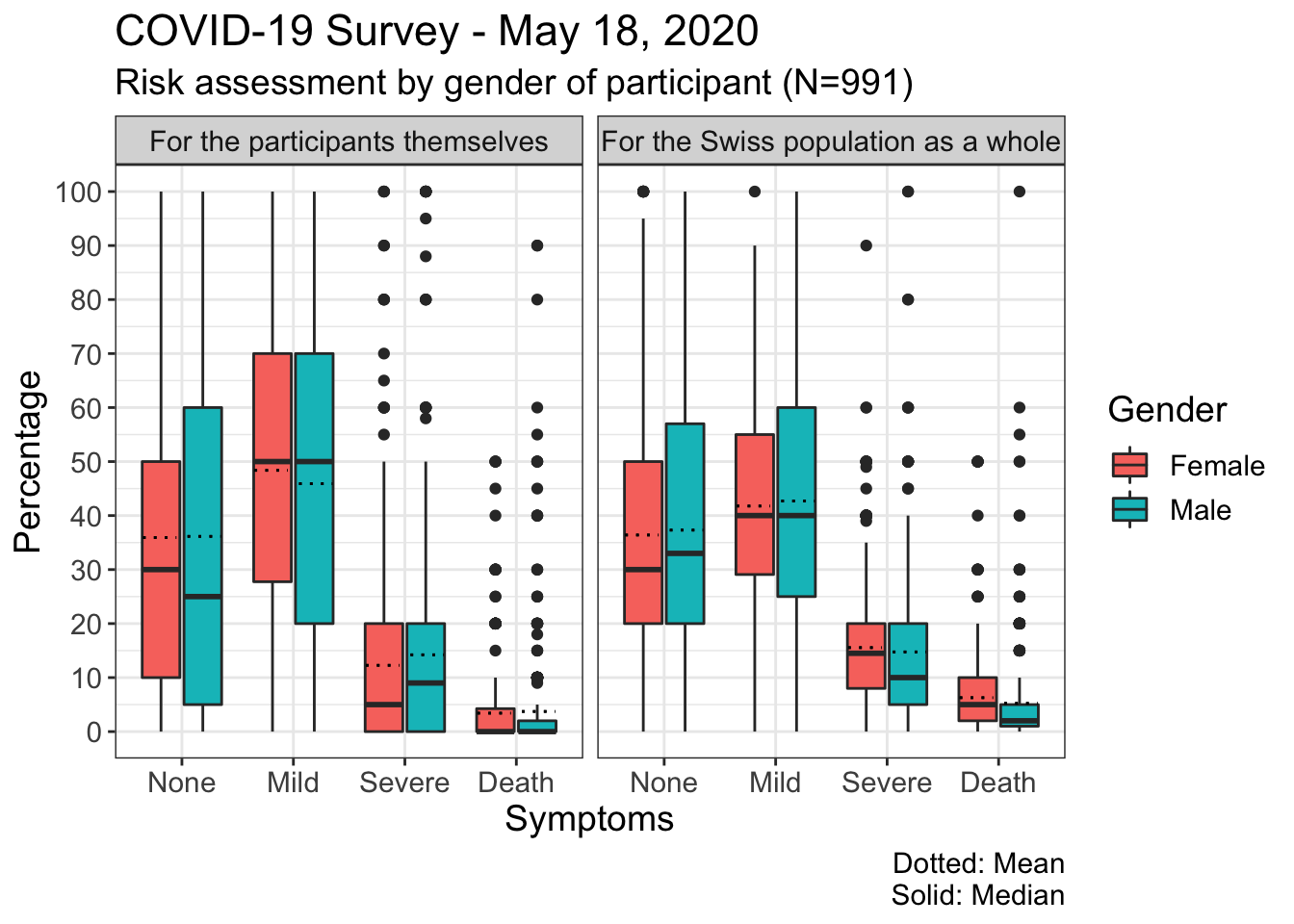
A first analysis from the survey on risk perception in the case of a COVID-19 infection shows that participants evaluate the risks of various outcomes differently for themselves and the Swiss population. The possibility that the participant experiences severe symptoms that require hospitalisation or fatal symptoms is considered somewhat lower by the participants for themselves than for the Swiss population. Both men and women appear to overestimate the probability of death by expecting the “asymptomatic” course to be less likely. While the median values for the various symptom categories do not differ greatly between men and women, the range of values for men is somewhat wider than for women
5 Average daily distance
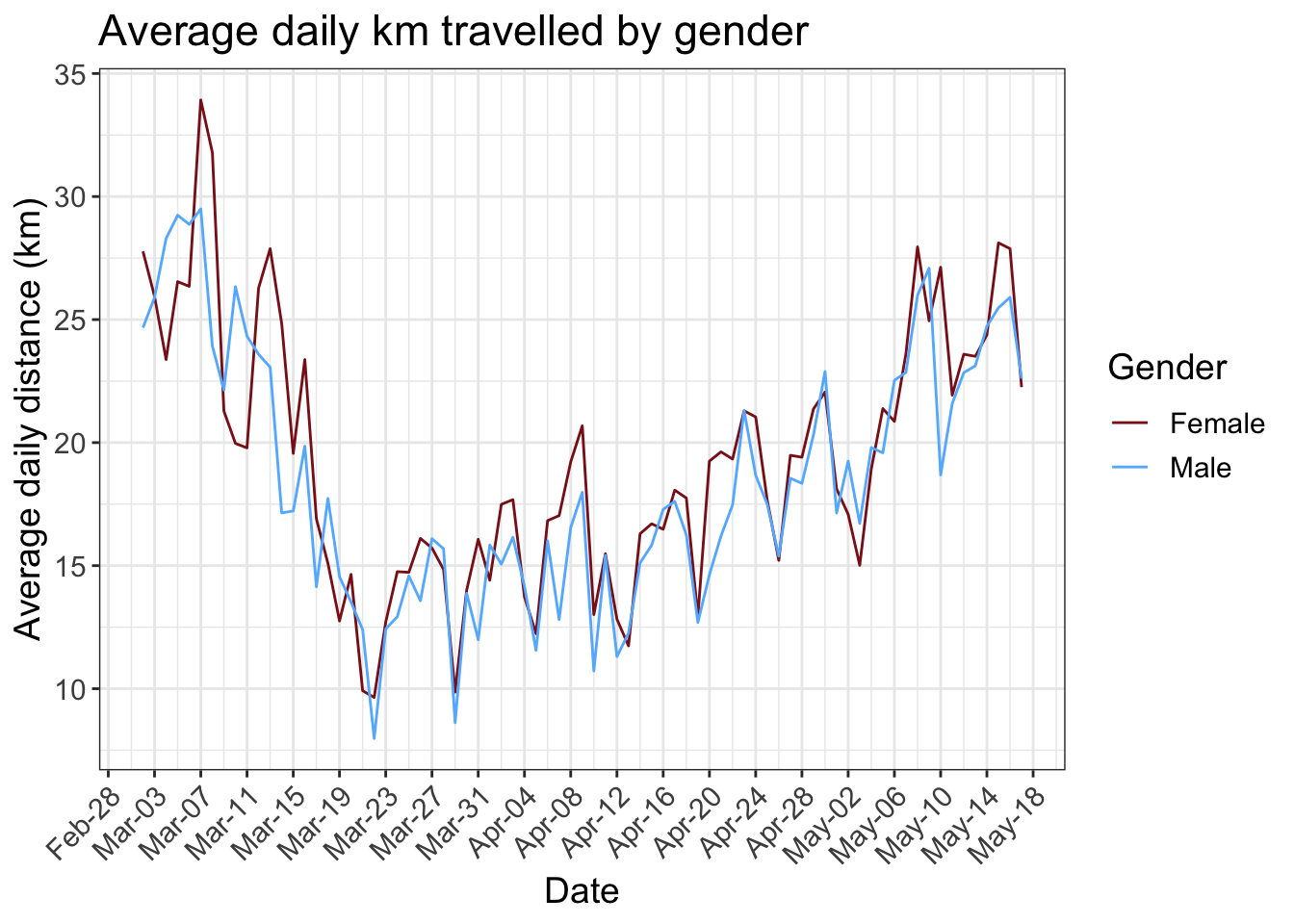
6 Active days
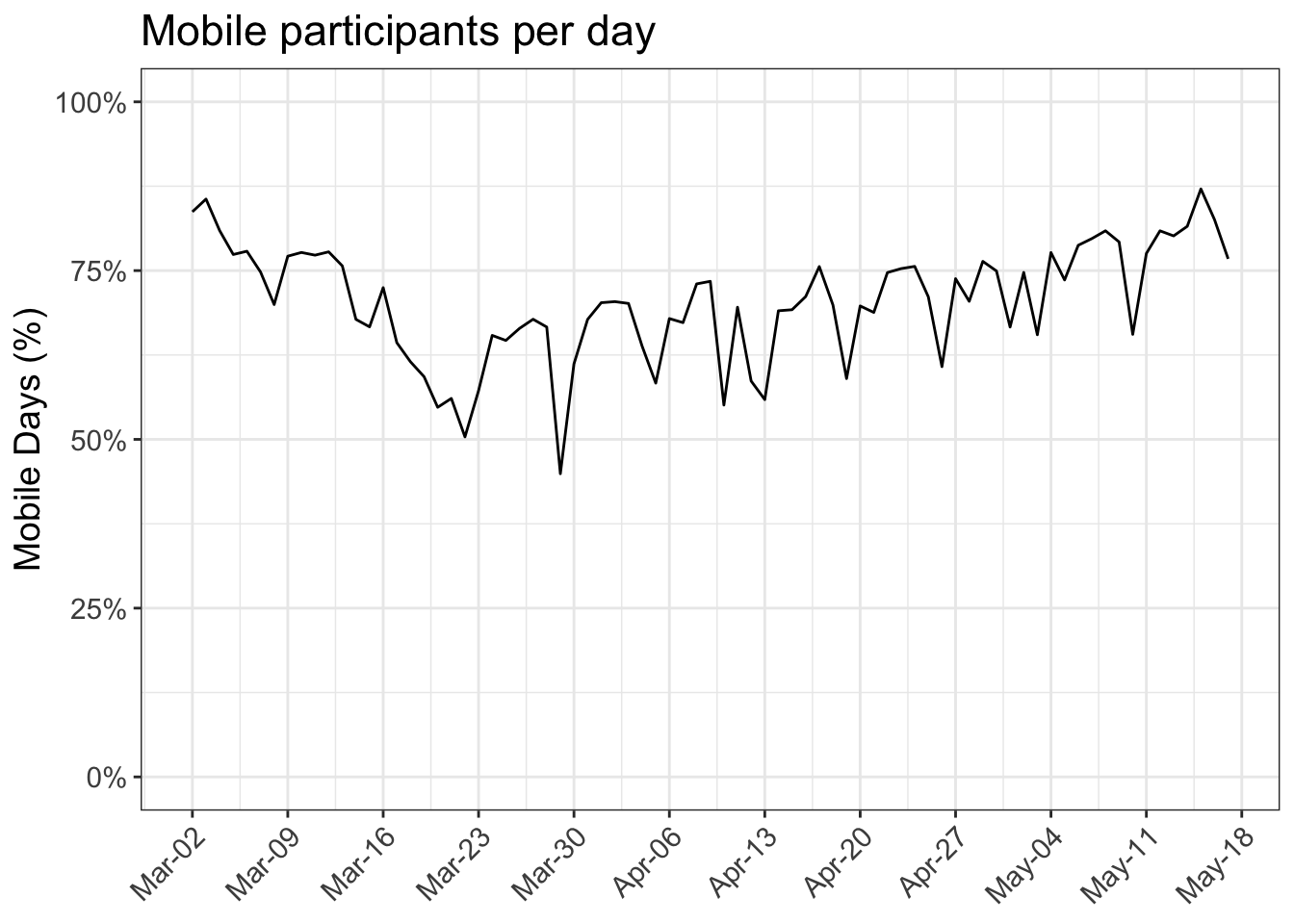
7 Change in kilometers travelled by transport mode
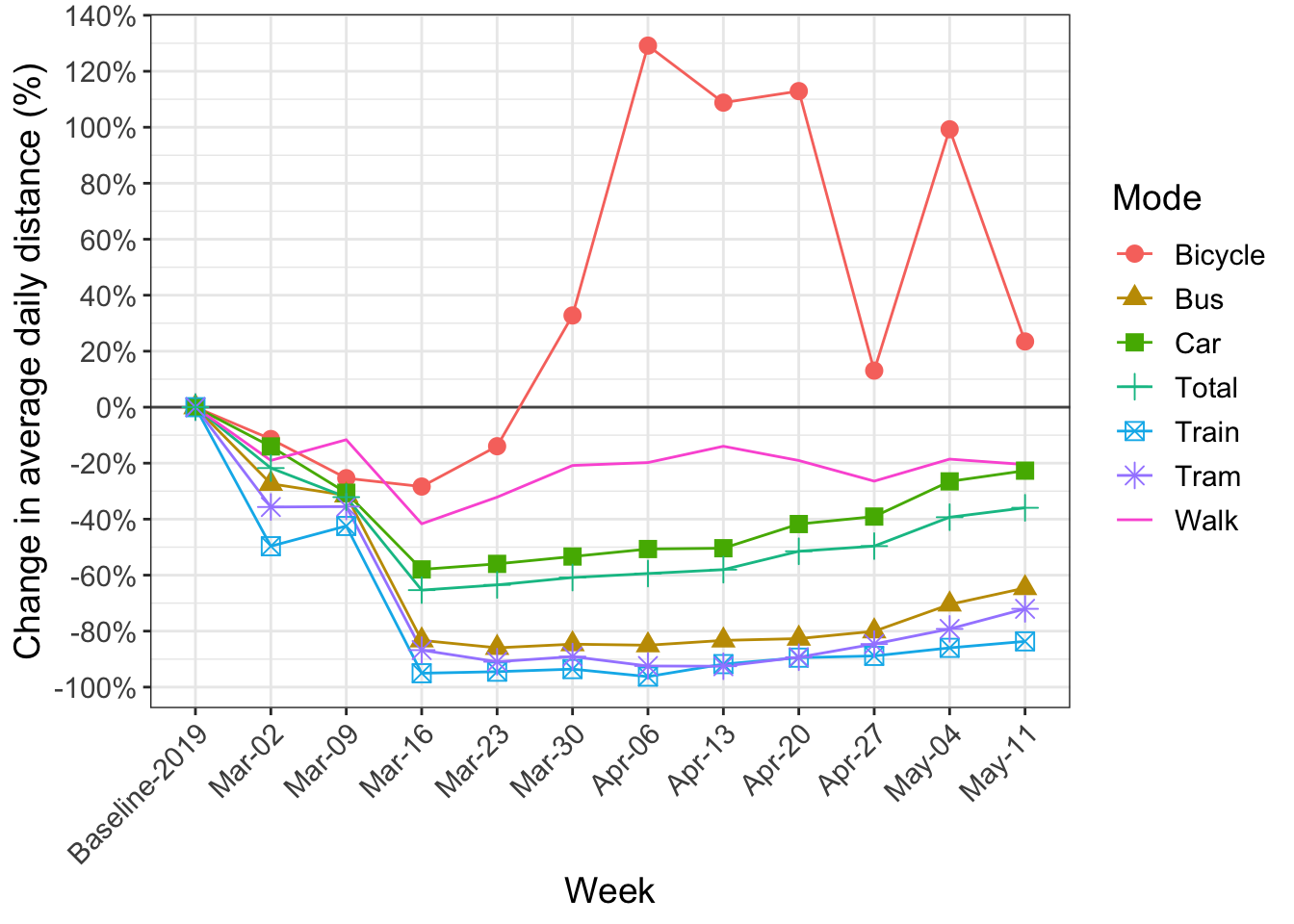
8 Change in kilometers travelled by:
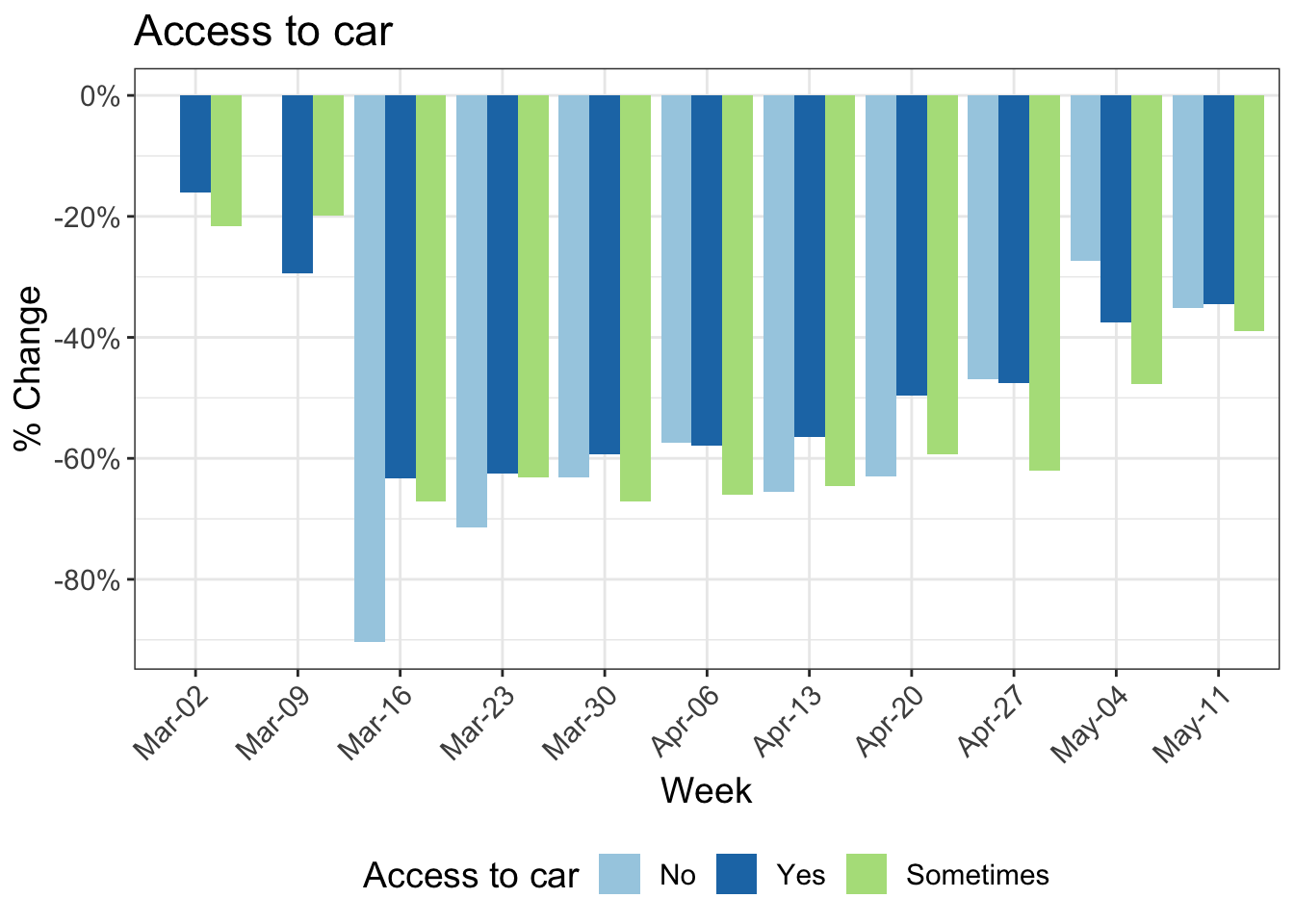
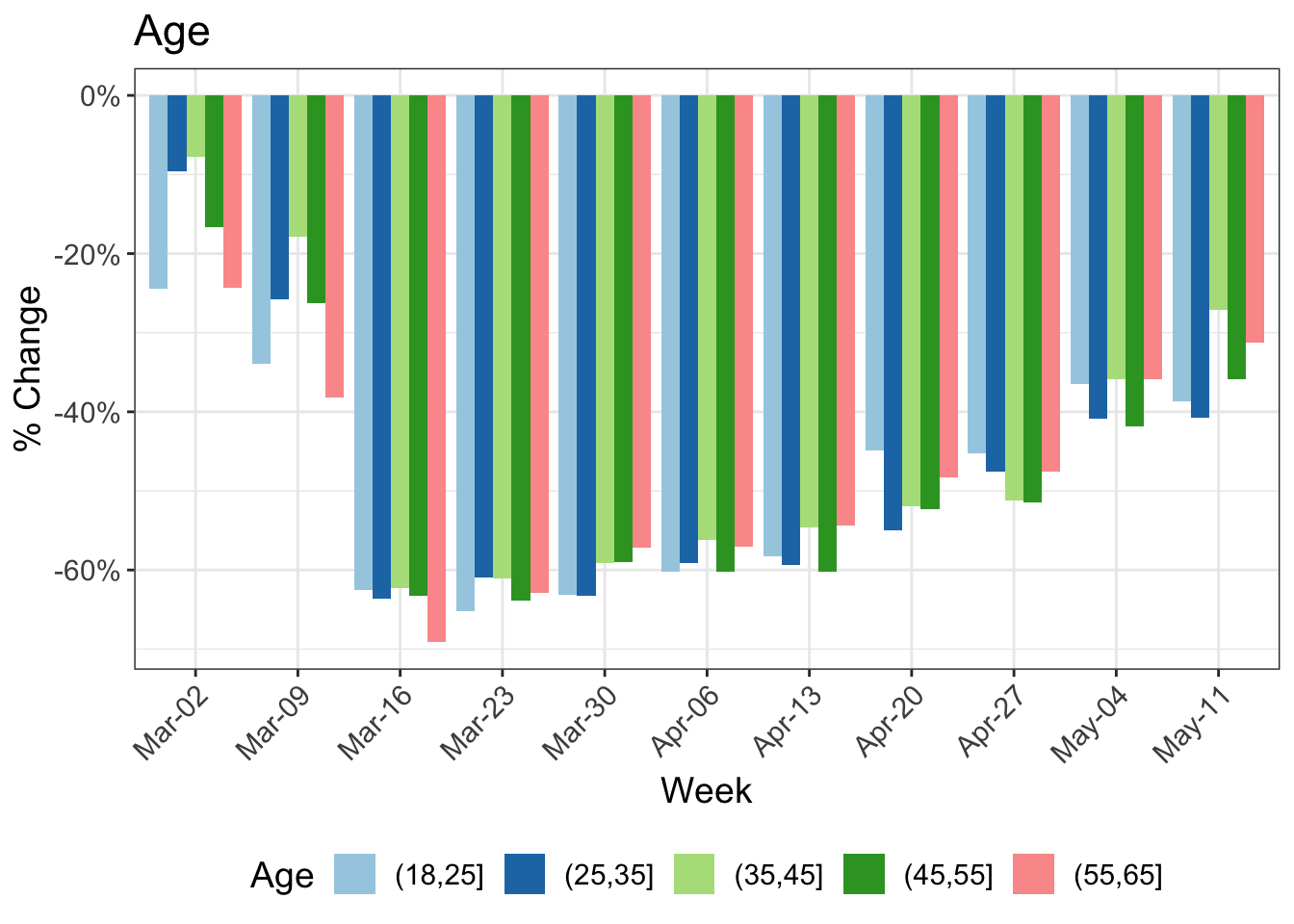
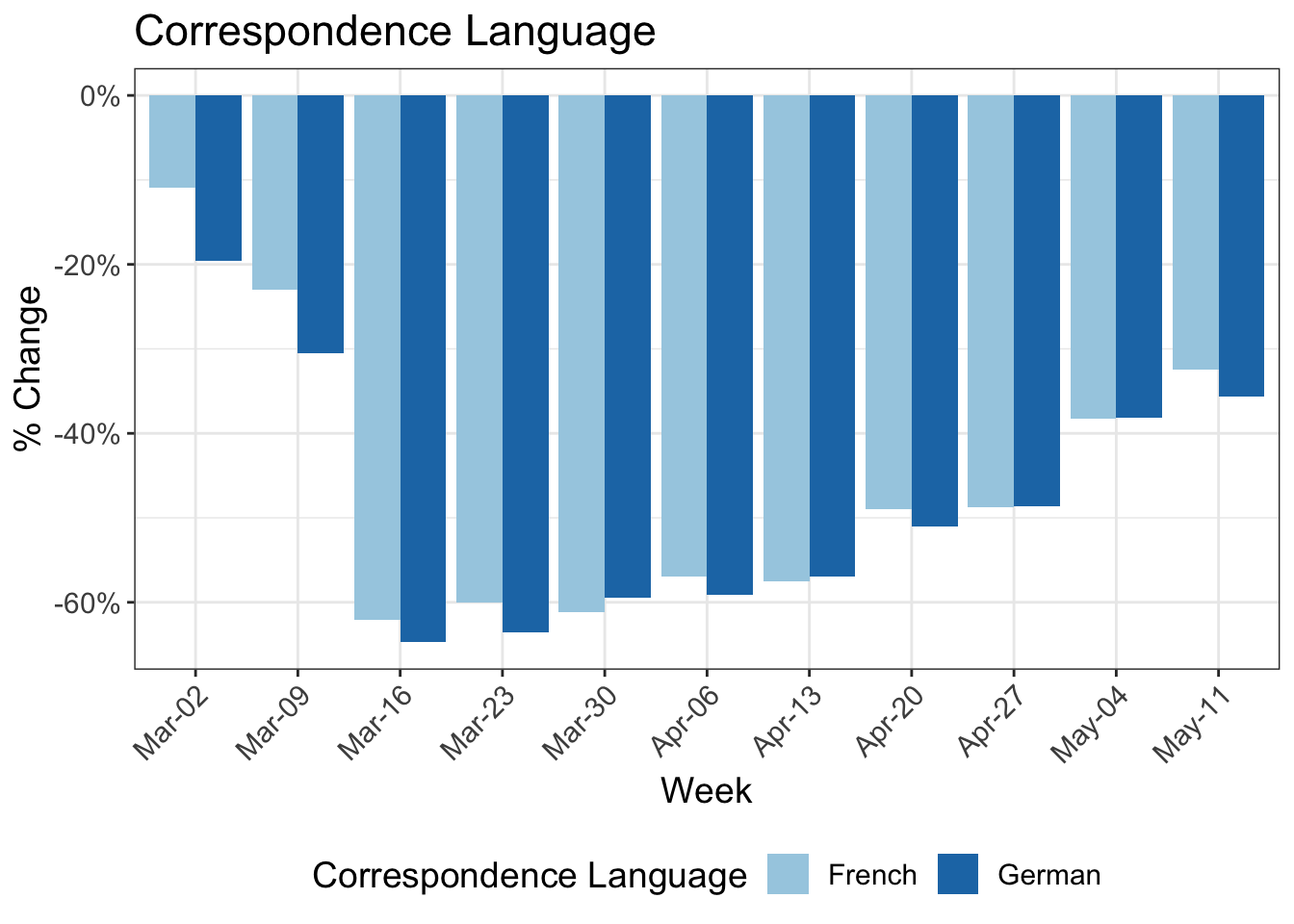
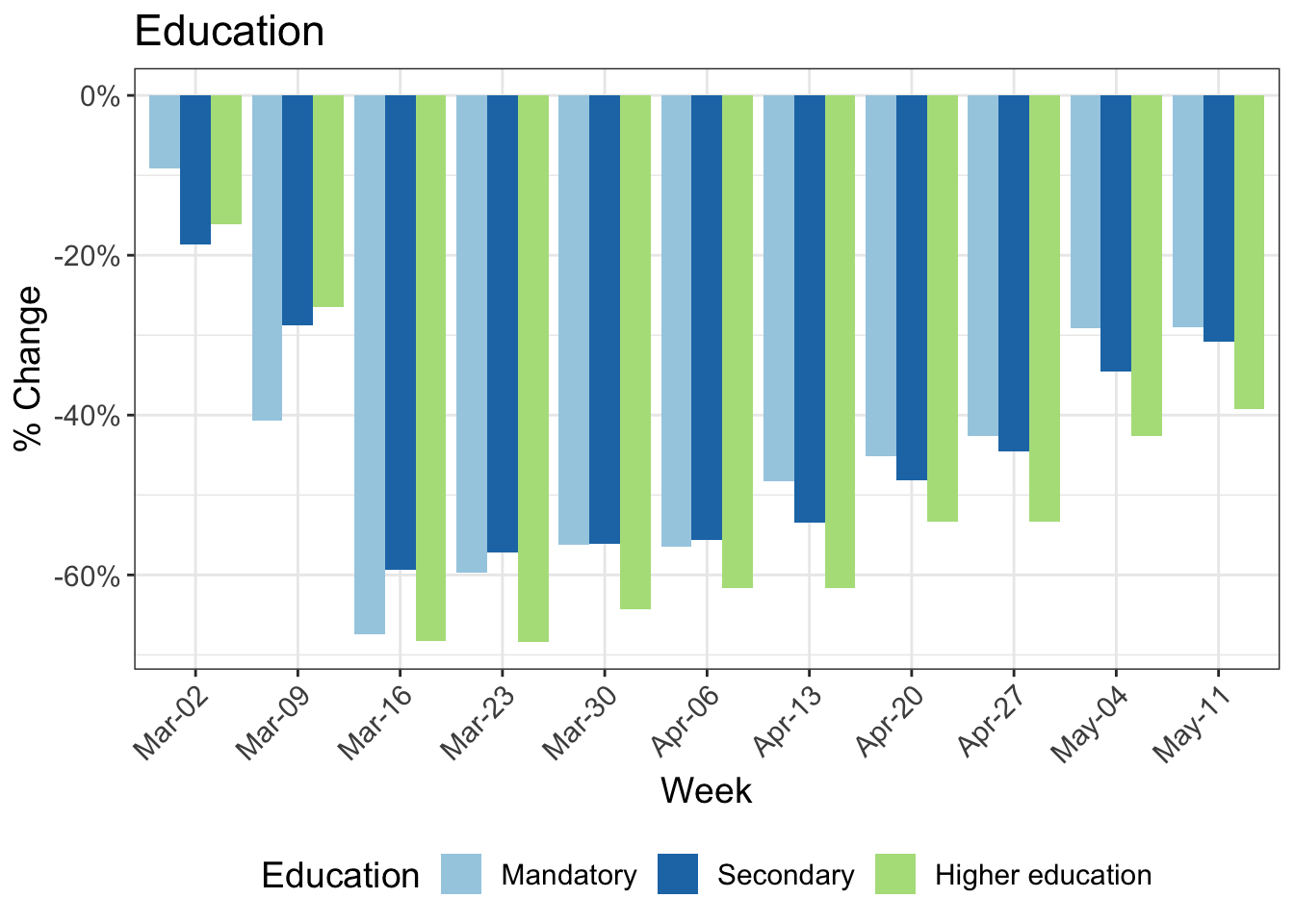
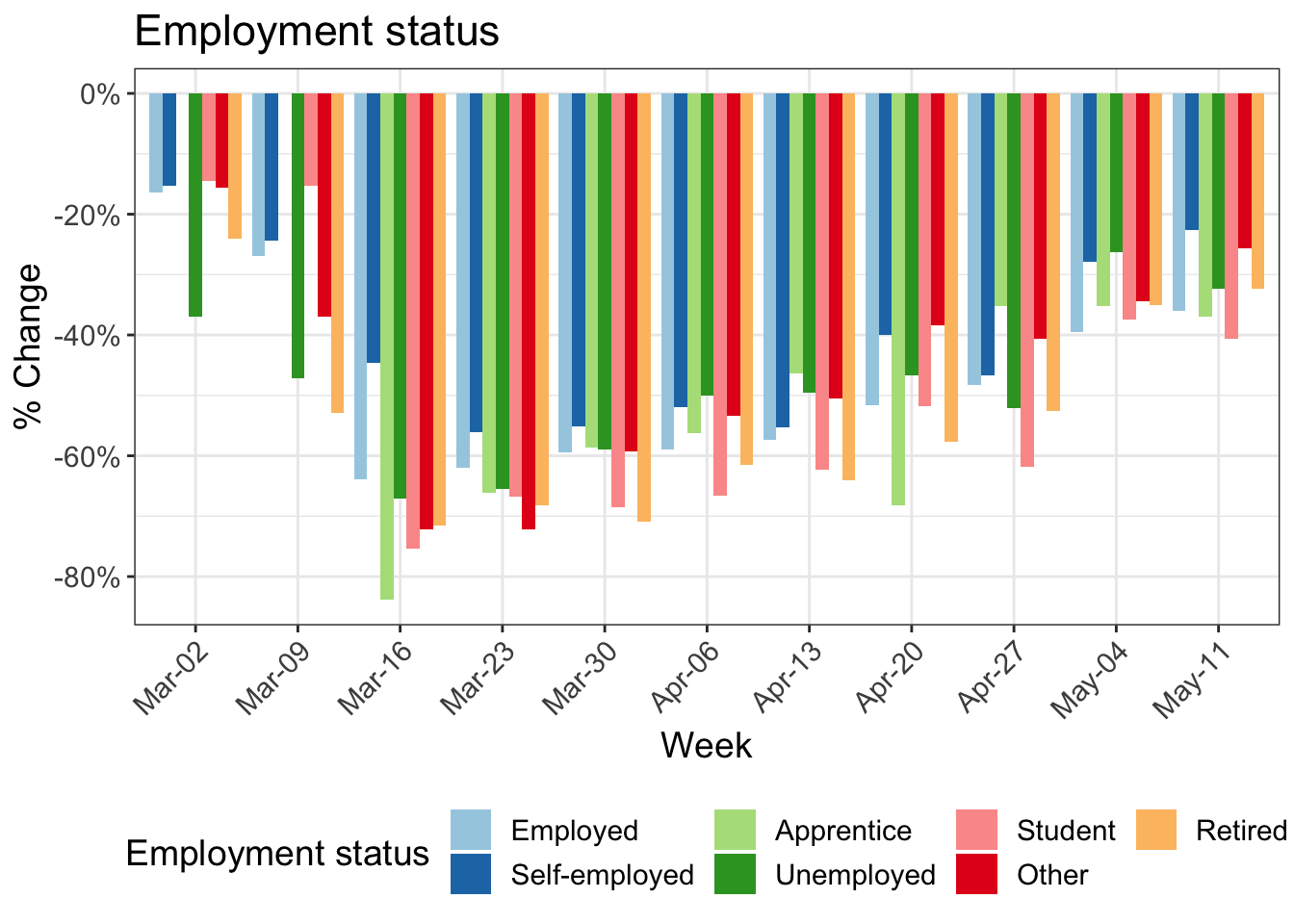
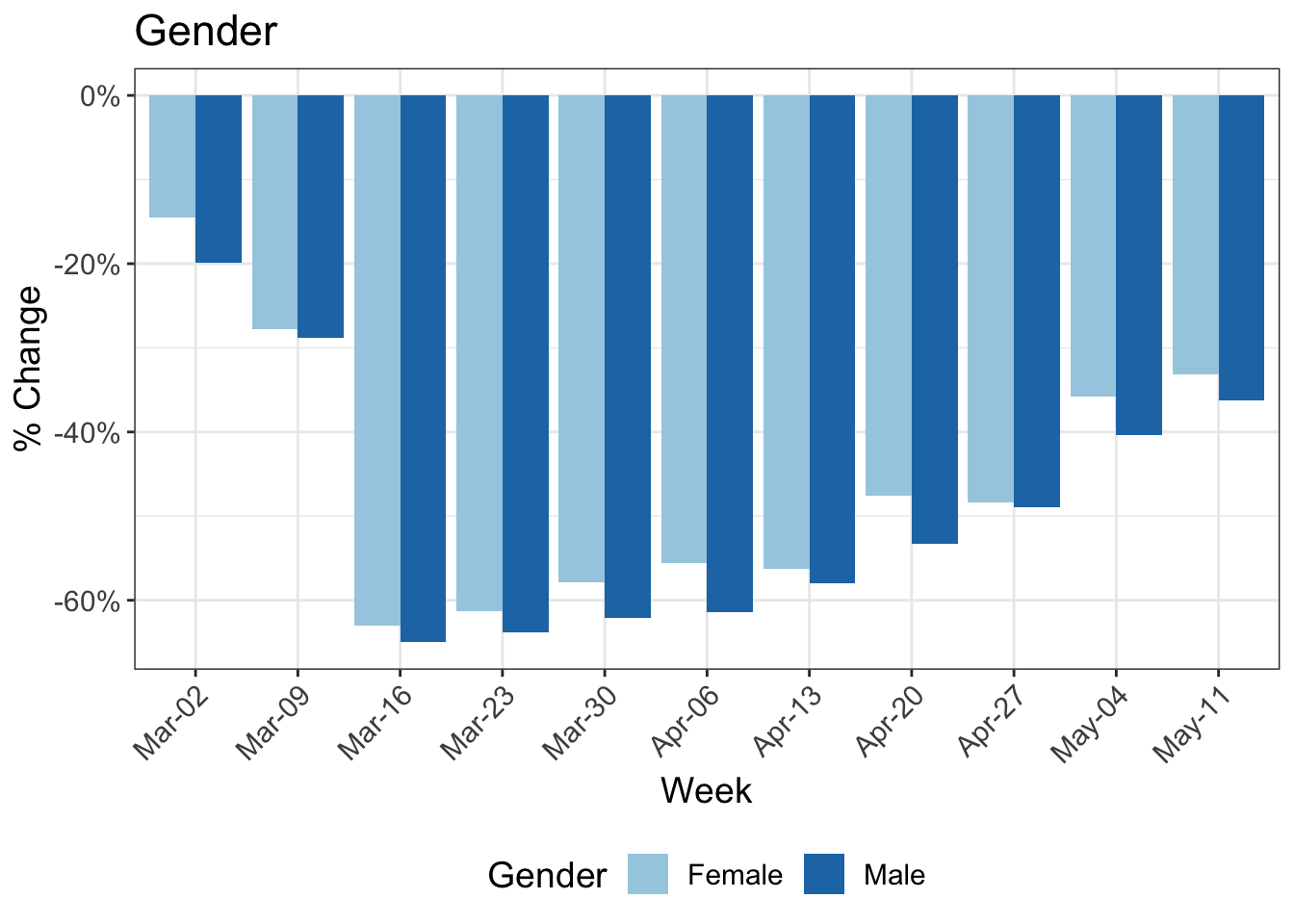
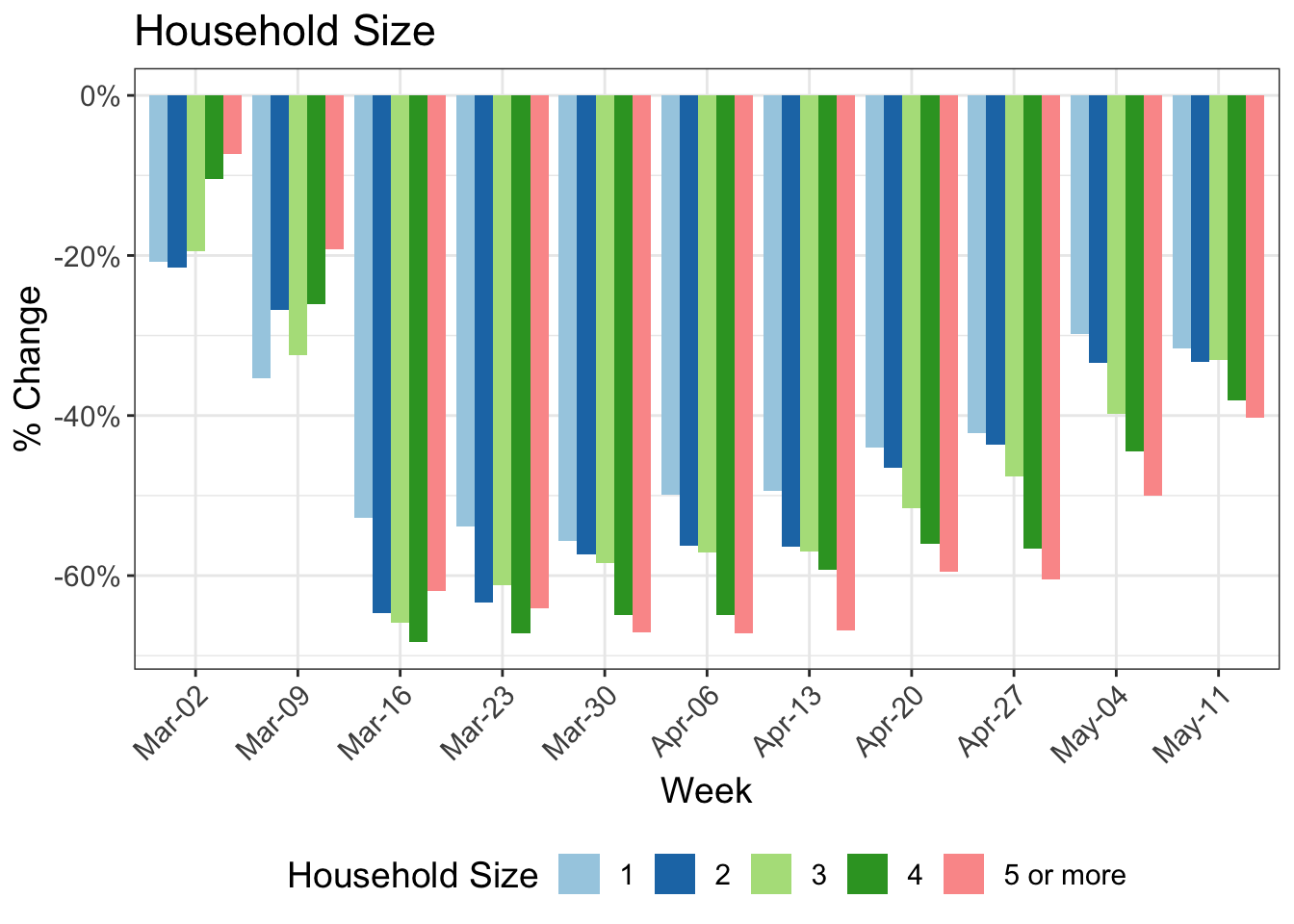
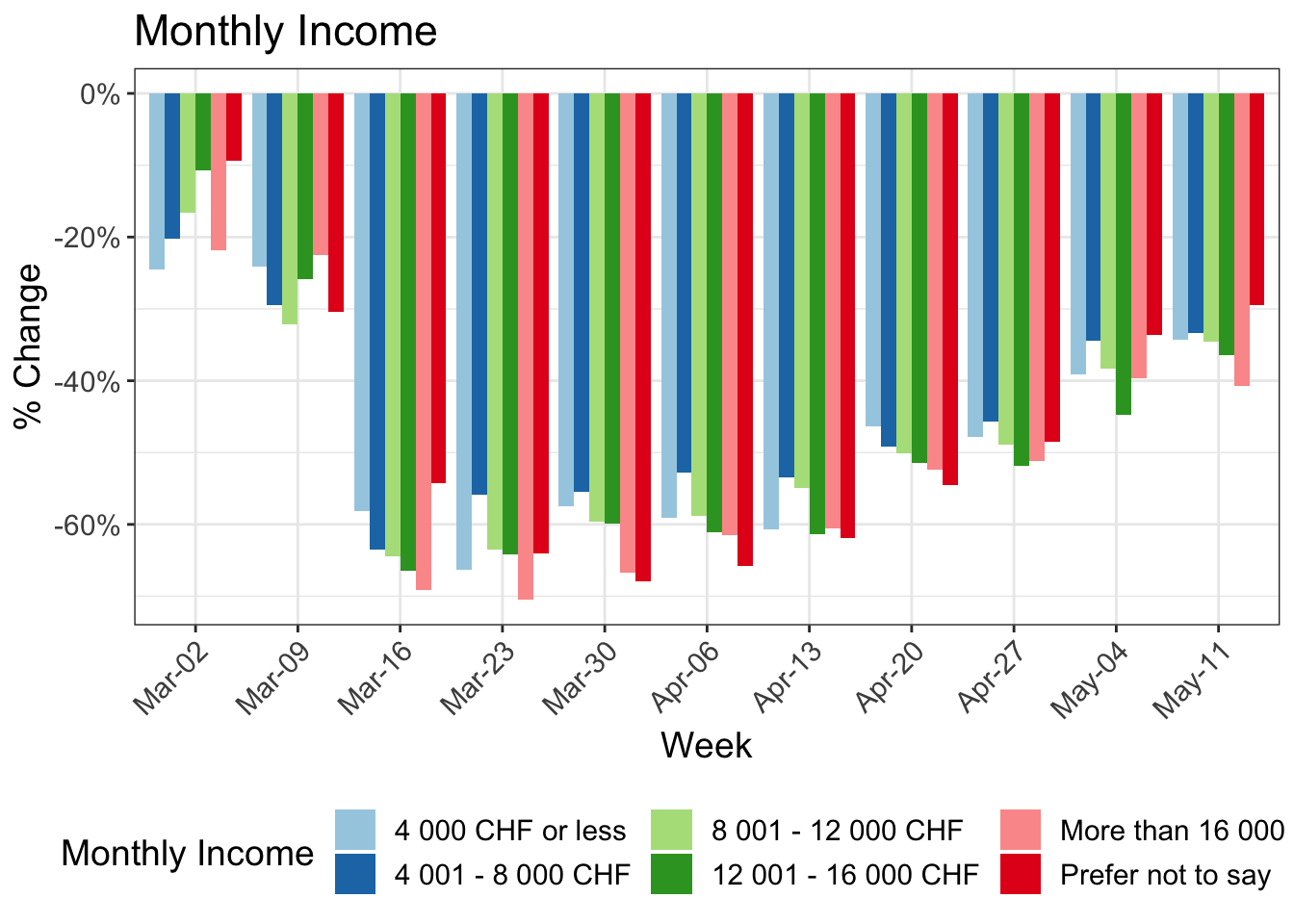
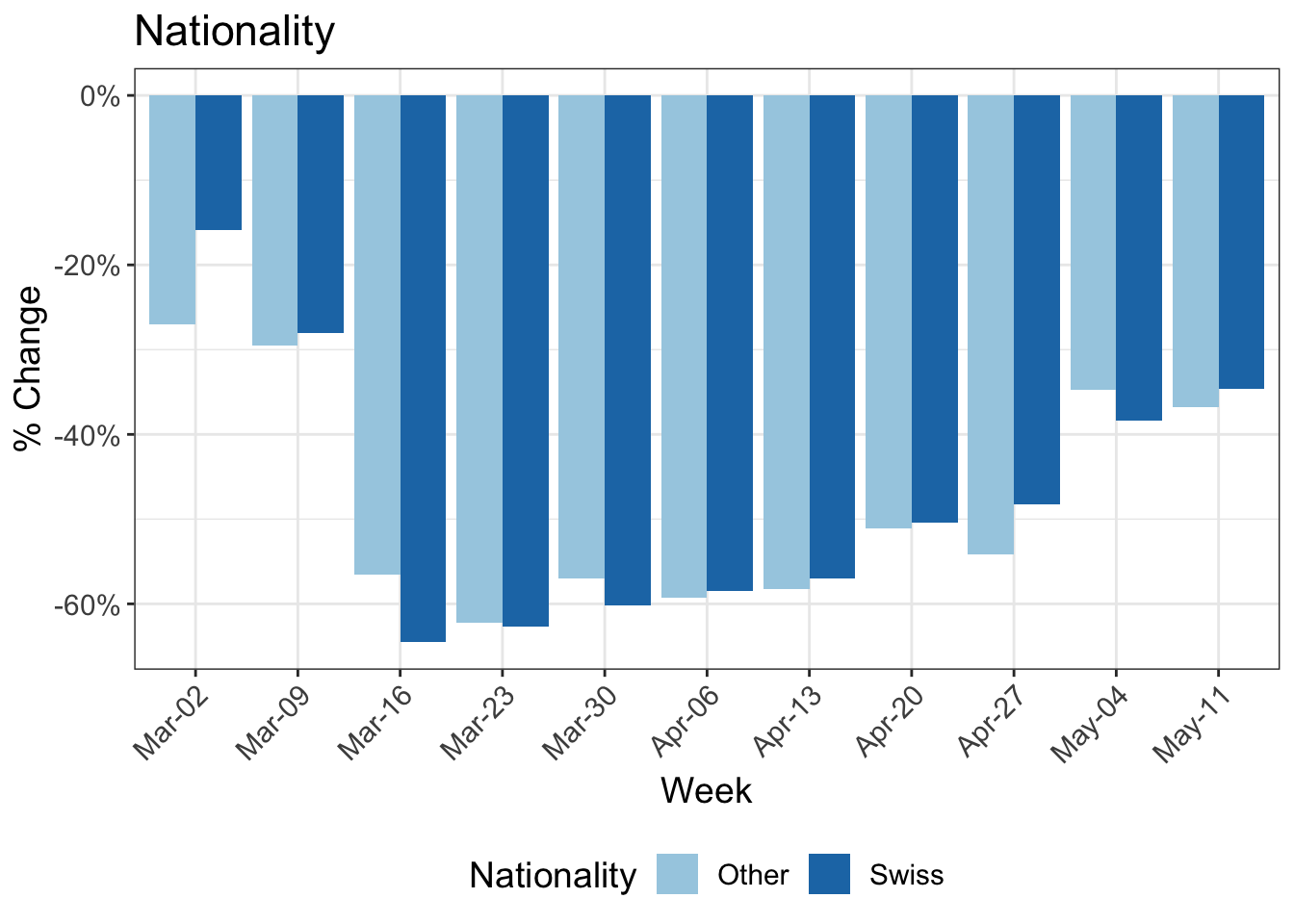
9 Reduction in kilometers travelled by canton
| Canton | N | Mar-02 | Mar-09 | Mar-16 | Mar-23 | Mar-30 | Apr-06 | Apr-13 | Apr-20 | Apr-27 | May-04 | May-11 |
|---|---|---|---|---|---|---|---|---|---|---|---|---|
| Aargau | 55 | -25 | -41 | -71 | -58 | -50 | -57 | -56 | -48 | -51 | -36 | -25 |
| Basel-Landschaft | 132 | -15 | -12 | -62 | -61 | -60 | -61 | -56 | -55 | -54 | -40 | -34 |
| Basel-Stadt | 31 | -14 | -36 | -70 | -75 | -68 | -62 | -67 | -58 | -58 | -42 | -56 |
| Bern | 133 | -31 | -36 | -67 | -60 | -57 | -57 | -51 | -49 | -46 | -42 | -37 |
| Geneva | 96 | 10 | -44 | -68 | -62 | -59 | -65 | -57 | -46 | -41 | -21 | -17 |
| Schwyz | 11 | -24 | -13 | -55 | -70 | -50 | -48 | -46 | -29 | -12 | -34 | -13 |
| Solothurn | 13 | -13 | -41 | -62 | -65 | -53 | -49 | -50 | -30 | -42 | -27 | -28 |
| Vaud | 213 | -8 | -22 | -65 | -71 | -68 | -65 | -64 | -56 | -58 | -43 | -41 |
| Zurich | 495 | -17 | -26 | -60 | -59 | -58 | -54 | -55 | -47 | -44 | -35 | -33 |
10 Trip duration by transport mode and gender
| Mode | Gender | Baseline-2019 | Mar-02 | Mar-09 | Mar-16 | Mar-23 | Mar-30 | Apr-06 | Apr-13 | Apr-20 | Apr-27 | May-04 | May-11 |
|---|---|---|---|---|---|---|---|---|---|---|---|---|---|
| Bicycle | Female | 15 | 15 | 16 | 14 | 19 | 27 | 31 | 38 | 29 | 23 | 31 | 22 |
| Male | 14 | 14 | 15 | 25 | 24 | 28 | 36 | 32 | 32 | 22 | 26 | 19 | |
| Bus | Female | 11 | 7 | 8 | 4 | 5 | 6 | 5 | 6 | 5 | 5 | 6 | 6 |
| Male | 11 | 8 | 9 | 7 | 7 | 6 | 7 | 7 | 6 | 6 | 7 | 7 | |
| Car | Female | 52 | 41 | 38 | 36 | 36 | 36 | 37 | 36 | 39 | 37 | 41 | 41 |
| Male | 51 | 47 | 42 | 34 | 34 | 35 | 35 | 35 | 36 | 38 | 42 | 42 | |
| Train | Female | 35 | 31 | 35 | 19 | 28 | 30 | 16 | 18 | 31 | 23 | 30 | 27 |
| Male | 35 | 25 | 33 | 12 | 26 | 23 | 19 | 24 | 25 | 26 | 30 | 25 | |
| Tram | Female | 15 | 13 | 16 | 8 | 14 | 14 | 9 | 8 | 13 | 14 | 15 | 13 |
| Male | 18 | 19 | 17 | 12 | 11 | 13 | 12 | 11 | 12 | 10 | 12 | 13 | |
| Walk | Female | 17 | 22 | 21 | 19 | 18 | 21 | 21 | 21 | 20 | 18 | 18 | 17 |
| Male | 17 | 20 | 20 | 16 | 18 | 20 | 21 | 21 | 19 | 18 | 18 | 16 |
11 Average trip length by transport mode (km)

12 Activity space and daily travel radius
A commonly used definition of the activity space is the 95% confidence ellipse of the activity locations, in this case weighted by duration. In the following analysis, the activities at the home location are included, for those that had the app activated on that day. This is an important metric which gives an idea of the area in which travel is being performed. The daily travel radius is also presented.
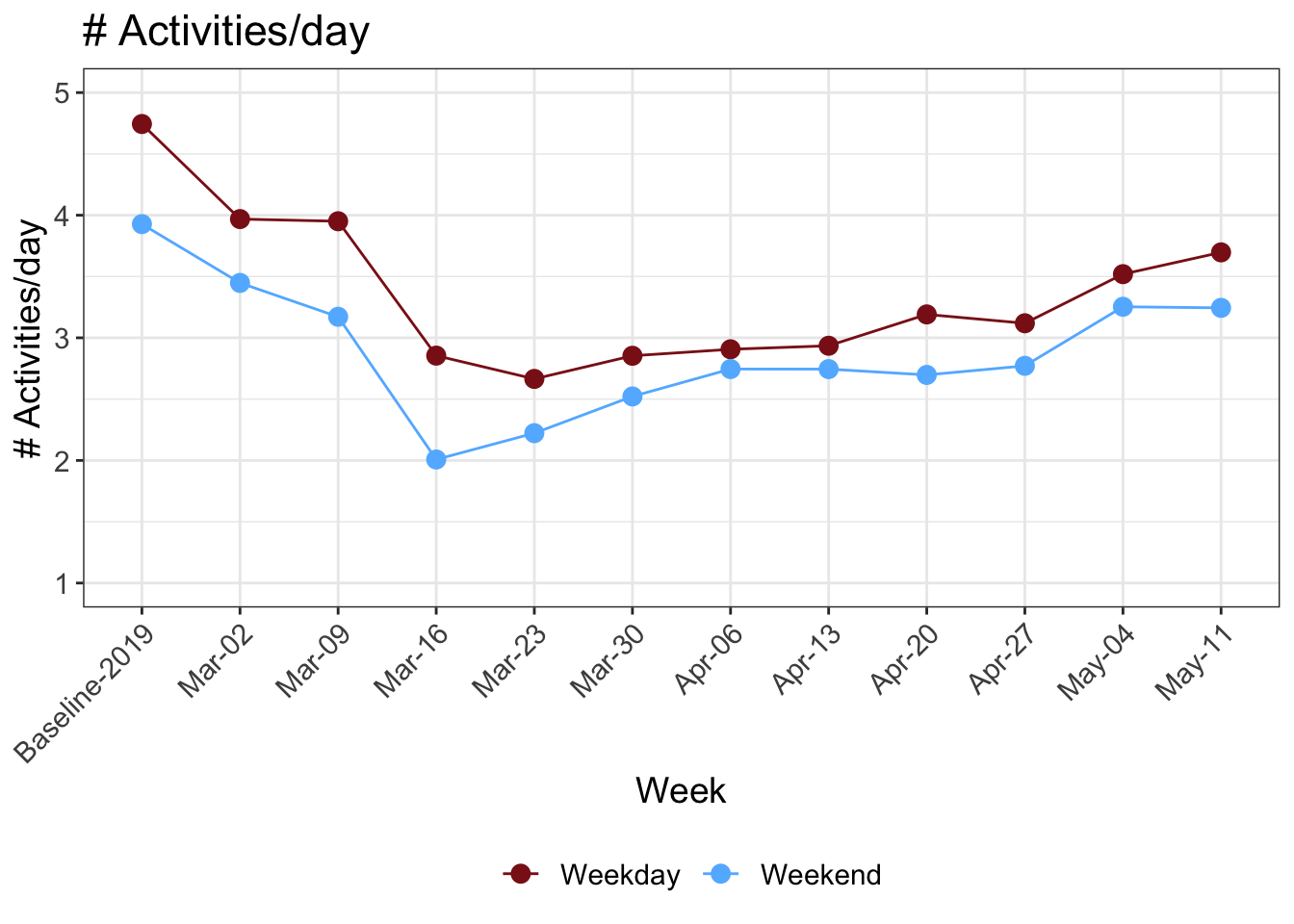
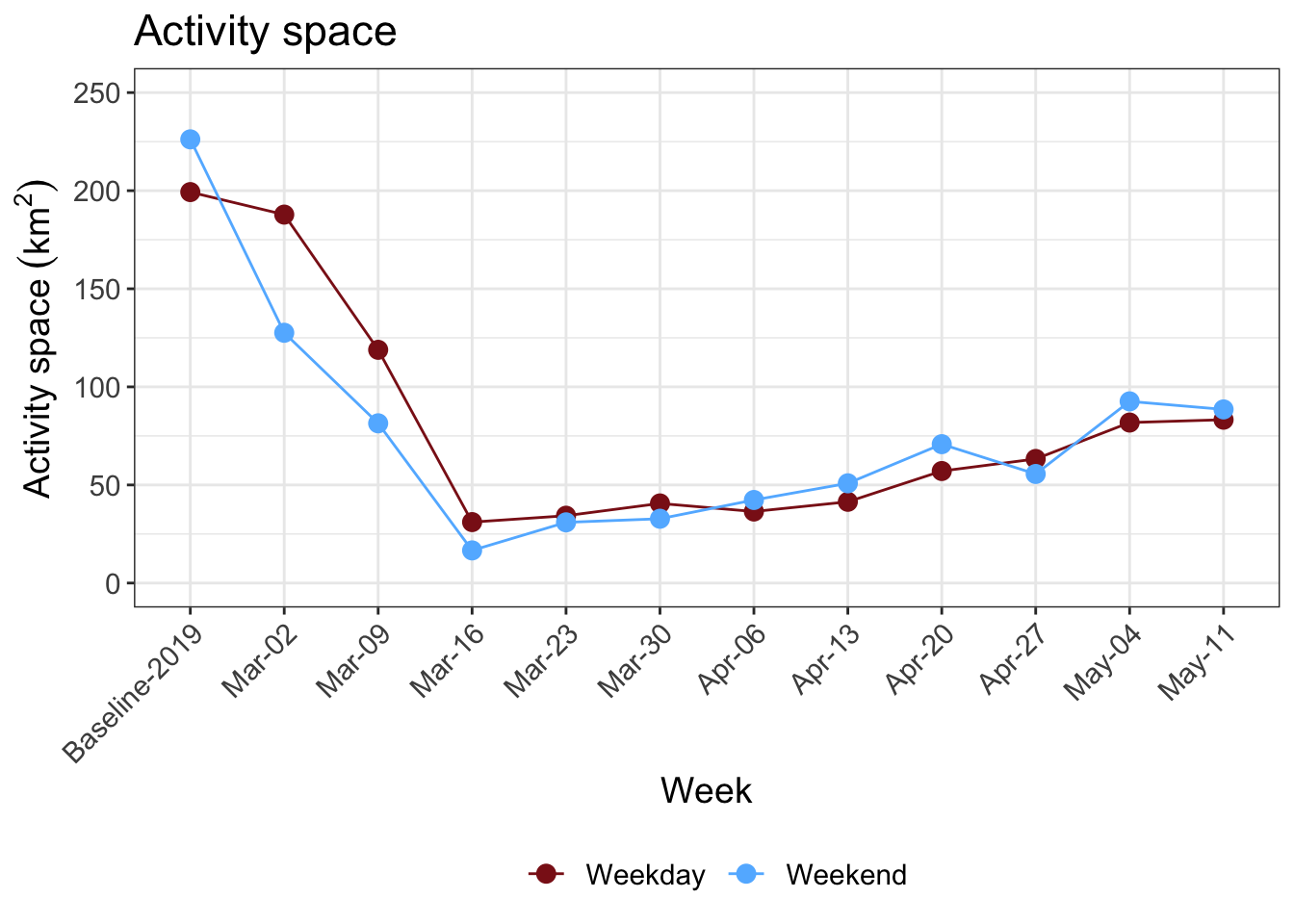
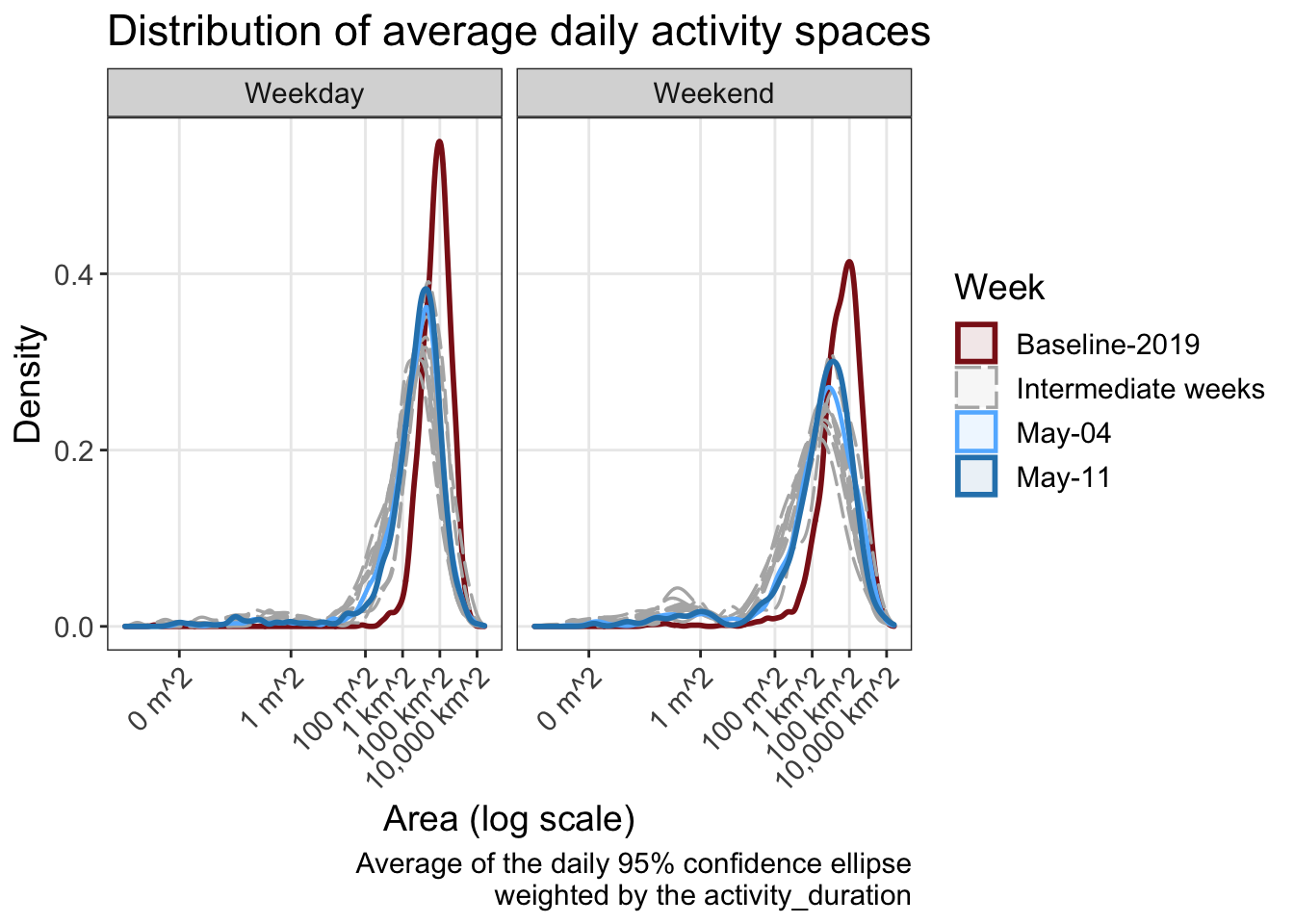
| Week | # Activities/day | Change | Area (km2) | Change | Daily Radius (km) | Change | |
|---|---|---|---|---|---|---|---|
| Baseline-2019 | Weekday | 4.74 | 199.29 | 10.07 | |||
| Weekend | 3.93 | 226.16 | 9.90 | ||||
| Mar-02 | Weekday | 3.97 | -16% | 187.80 | -6% | 8.66 | -14% |
| Weekend | 3.45 | -12% | 127.57 | -44% | 8.03 | -19% | |
| Mar-09 | Weekday | 3.95 | -17% | 118.88 | -40% | 7.33 | -27% |
| Weekend | 3.17 | -19% | 81.42 | -64% | 5.87 | -41% | |
| Mar-16 | Weekday | 2.85 | -40% | 31.06 | -84% | 3.93 | -61% |
| Weekend | 2.01 | -49% | 16.63 | -93% | 2.26 | -77% | |
| Mar-23 | Weekday | 2.66 | -44% | 34.32 | -83% | 3.58 | -64% |
| Weekend | 2.22 | -43% | 30.94 | -86% | 3.15 | -68% | |
| Mar-30 | Weekday | 2.85 | -40% | 40.58 | -80% | 3.78 | -62% |
| Weekend | 2.52 | -36% | 32.77 | -86% | 3.63 | -63% | |
| Apr-06 | Weekday | 2.91 | -39% | 36.46 | -82% | 4.01 | -60% |
| Weekend | 2.75 | -30% | 42.34 | -81% | 3.73 | -62% | |
| Apr-13 | Weekday | 2.94 | -38% | 41.41 | -79% | 4.25 | -58% |
| Weekend | 2.74 | -30% | 50.84 | -78% | 4.17 | -58% | |
| Apr-20 | Weekday | 3.19 | -33% | 57.10 | -71% | 4.84 | -52% |
| Weekend | 2.70 | -31% | 70.79 | -69% | 4.63 | -53% | |
| Apr-27 | Weekday | 3.12 | -34% | 63.25 | -68% | 4.95 | -51% |
| Weekend | 2.77 | -29% | 55.59 | -75% | 5.00 | -49% | |
| May-04 | Weekday | 3.52 | -26% | 81.81 | -59% | 5.82 | -42% |
| Weekend | 3.25 | -17% | 92.61 | -59% | 7.09 | -28% | |
| May-11 | Weekday | 3.70 | -22% | 83.26 | -58% | 6.03 | -40% |
| Weekend | 3.24 | -17% | 88.51 | -61% | 5.38 | -46% |
| Age | 2019 | Mar-02 | Mar-09 | Mar-16 | Mar-23 | Mar-30 | Apr-06 | Apr-13 | Apr-20 | Apr-27 | May-04 | May-11 | |
|---|---|---|---|---|---|---|---|---|---|---|---|---|---|
| (18,25] | Weekday | 60.9 | 35.8 | 49.8 | 6.9 | 2.7 | 3.2 | 5.7 | 7.0 | 10.6 | 10.1 | 19.2 | 16.3 |
| Weekend | 35.6 | 5.9 | 10.2 | 0.6 | 0.9 | 0.8 | 1.3 | 1.3 | 2.4 | 4.1 | 8.8 | 23.1 | |
| (25,35] | Weekday | 70.9 | 85.2 | 42.6 | 2.3 | 4.9 | 4.6 | 7.4 | 6.3 | 10.6 | 15.0 | 15.4 | 14.8 |
| Weekend | 42.4 | 14.5 | 3.3 | 0.4 | 0.6 | 1.4 | 2.3 | 1.8 | 1.8 | 7.1 | 9.3 | 24.4 | |
| (35,45] | Weekday | 74.9 | 36.4 | 75.0 | 6.8 | 3.3 | 7.6 | 8.2 | 9.2 | 12.0 | 14.9 | 24.8 | 28.9 |
| Weekend | 24.9 | 29.9 | 20.5 | 0.4 | 1.6 | 0.8 | 1.4 | 1.5 | 2.6 | 4.1 | 10.5 | 21.6 | |
| (45,55] | Weekday | 73.9 | 40.5 | 53.8 | 4.0 | 3.1 | 4.4 | 6.9 | 5.4 | 9.9 | 14.3 | 20.3 | 17.7 |
| Weekend | 28.1 | 13.3 | 7.0 | 0.7 | 1.2 | 1.6 | 1.7 | 2.3 | 2.6 | 2.4 | 5.8 | 13.1 | |
| (55,65] | Weekday | 68.5 | 79.9 | 45.0 | 7.3 | 2.8 | 5.8 | 5.3 | 7.8 | 10.1 | 10.2 | 17.1 | 24.3 |
| Weekend | 21.4 | 9.1 | 8.7 | 0.1 | 1.2 | 1.1 | 1.2 | 3.8 | 2.3 | 1.7 | 5.7 | 9.1 |
13 Hourly counts
The number of trips started per hour. The y axis is normalized by the maximum hourly value in the graph.
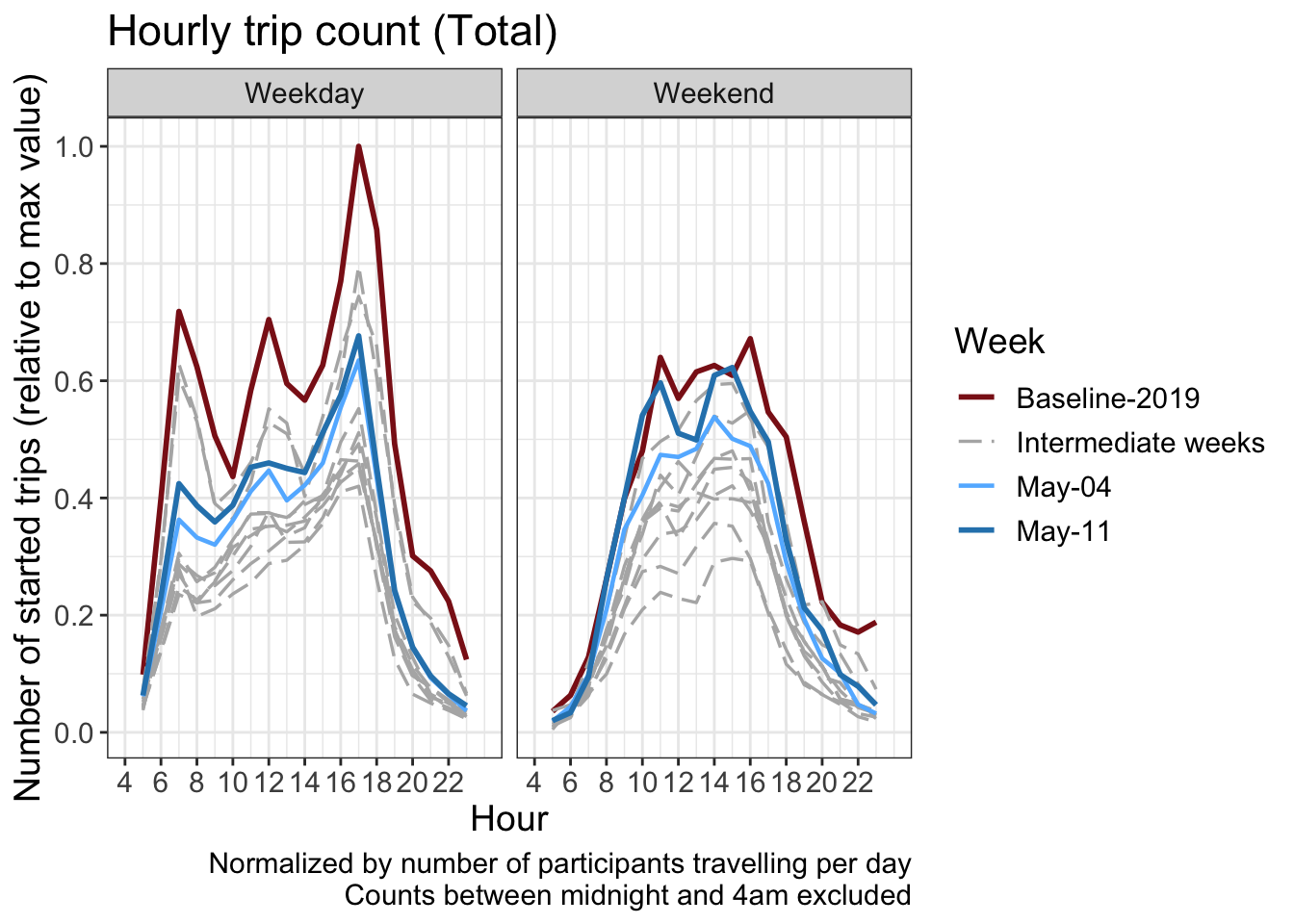



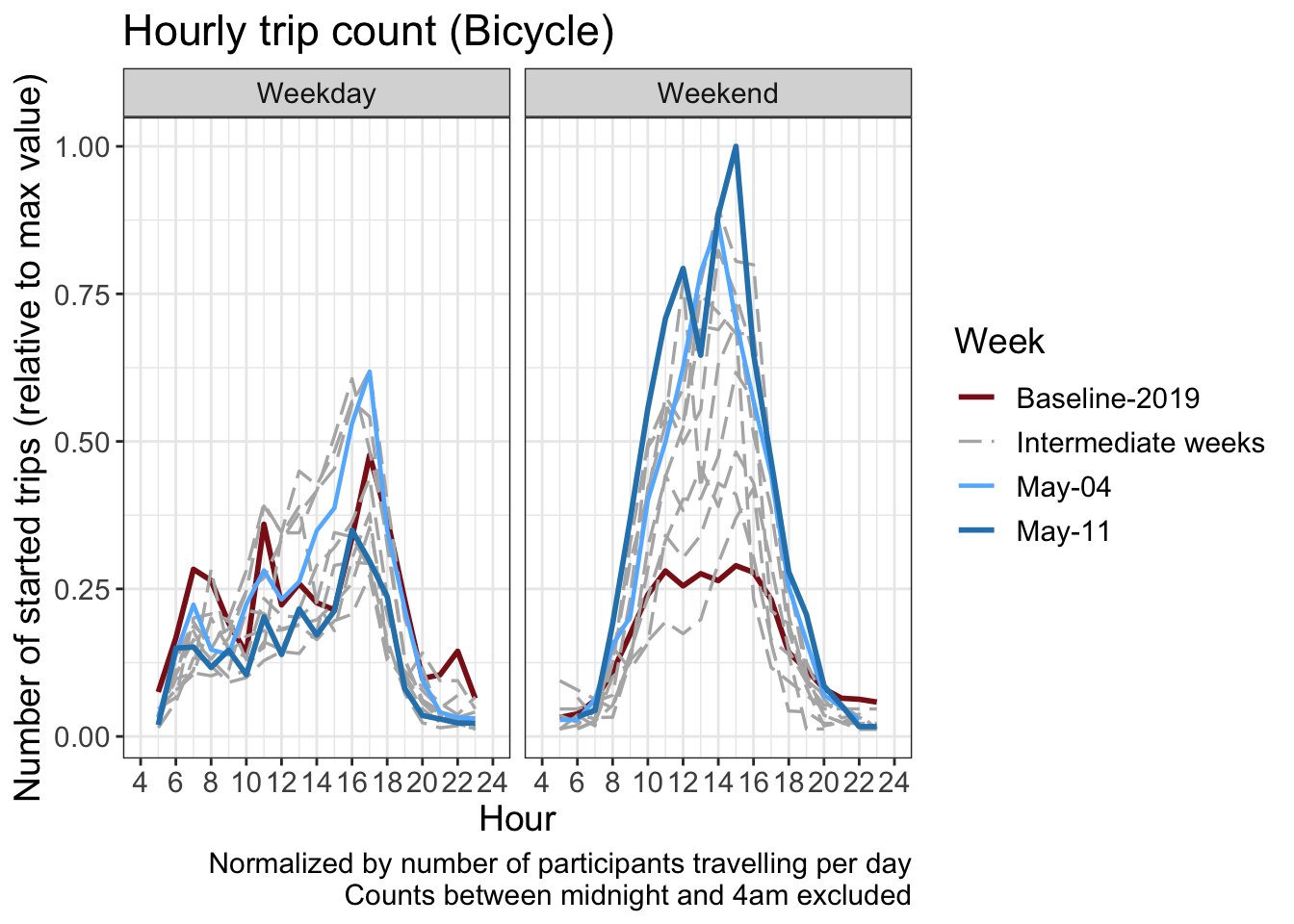
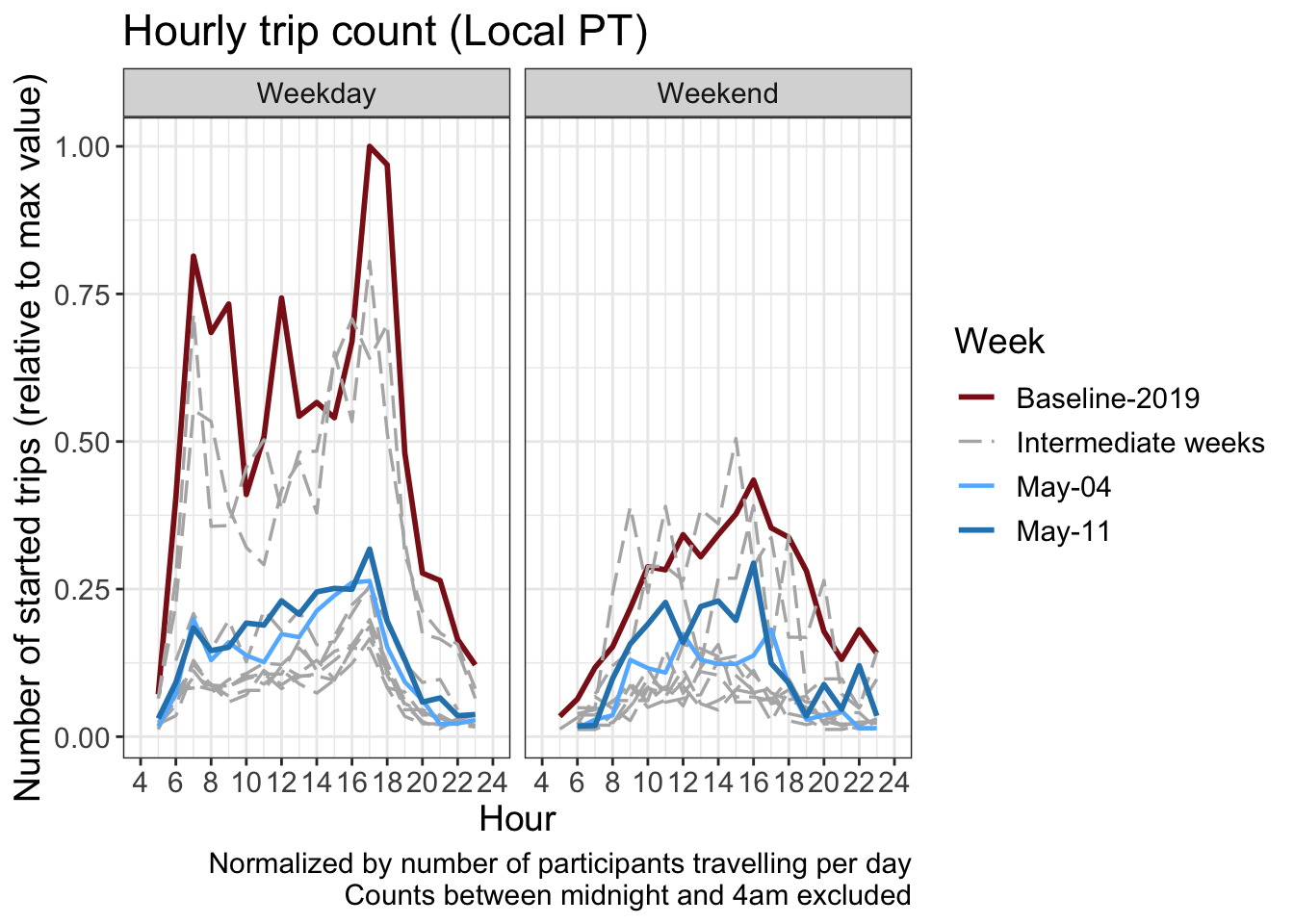
14 Activity types and zoning
Around 30% of activities were voluntarily labelled with their purpose by participants using the app. Work is ongoing to impute the purposes for the rest of the activities. Using simplification of the ARE development zoning classification, the activities are assigned with the closest zone classification within a 100m radius. The following graph shows how both the activity duration and the number of activites has changed from the baseline period in 2019 to the COVID-19 period.
Please note that only stationary leisure activites are included, not walking/cycling/hiking/etc

15 Participation
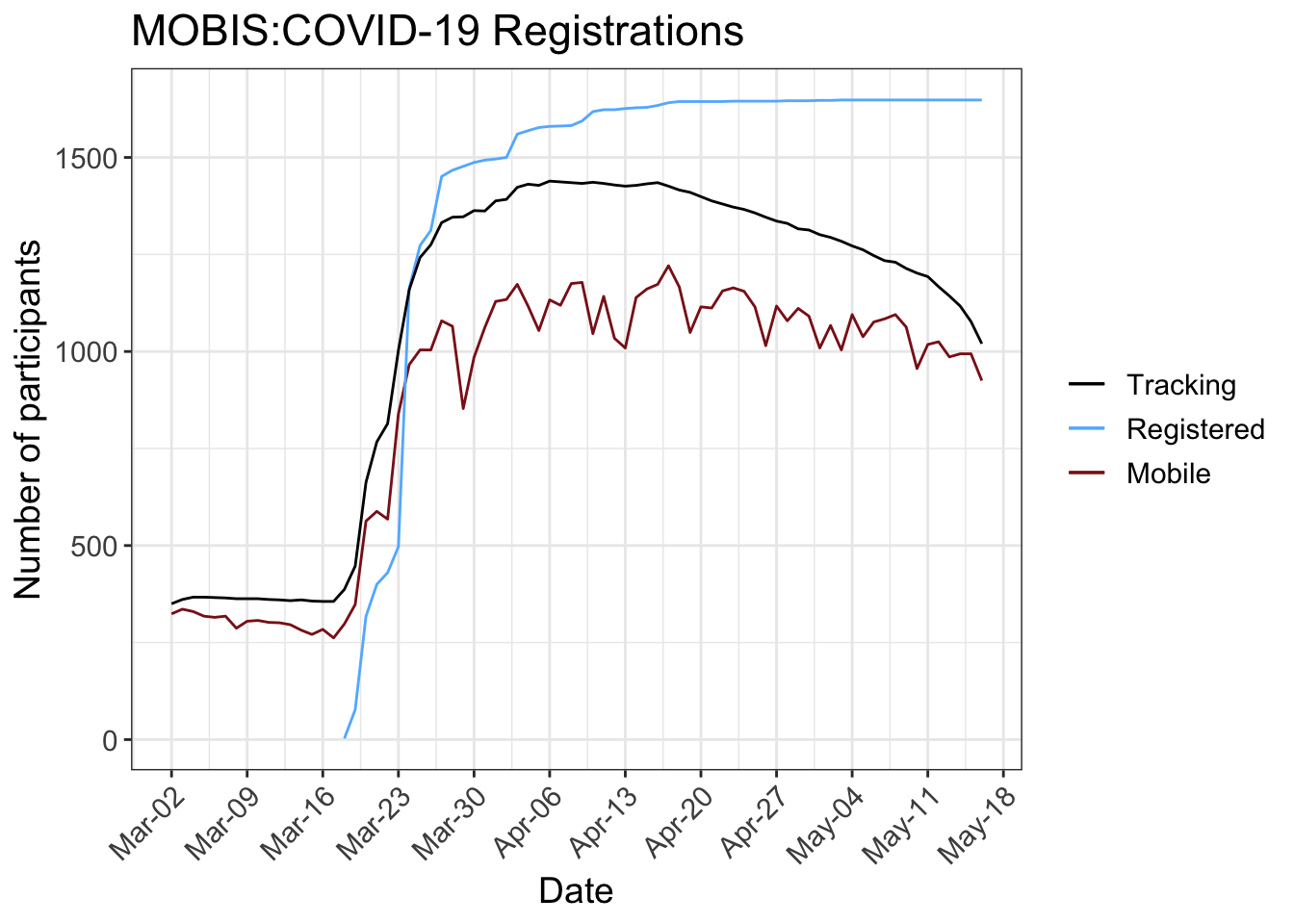
16 Differences in the distributions
The following charts show the characteristics of the MOBIS:COVID-19 sample compared to the original MOBIS Sample. There are some small differences, but generally the samples are consistent. This chart will be extended to compare to the relevant census data.
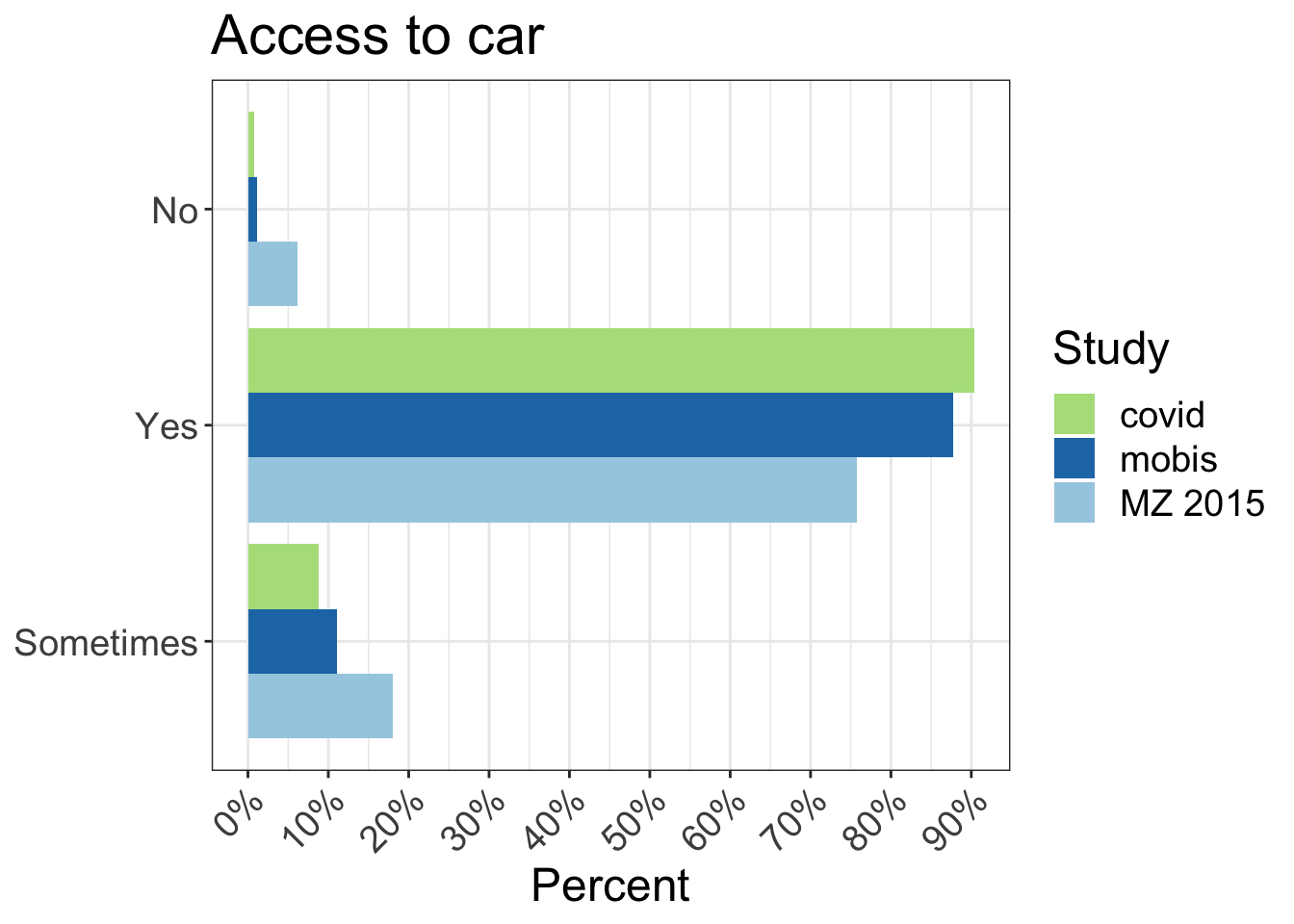
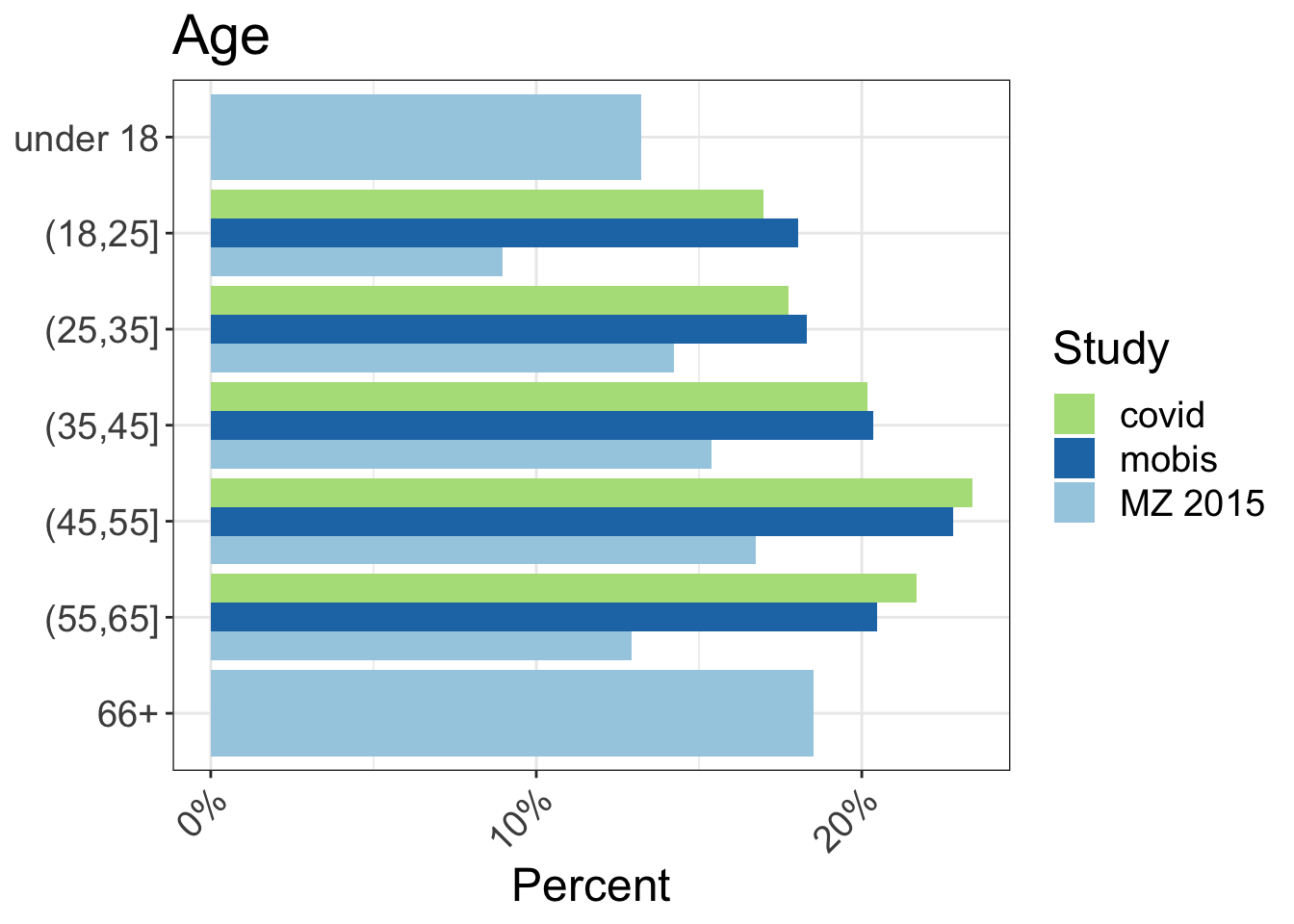
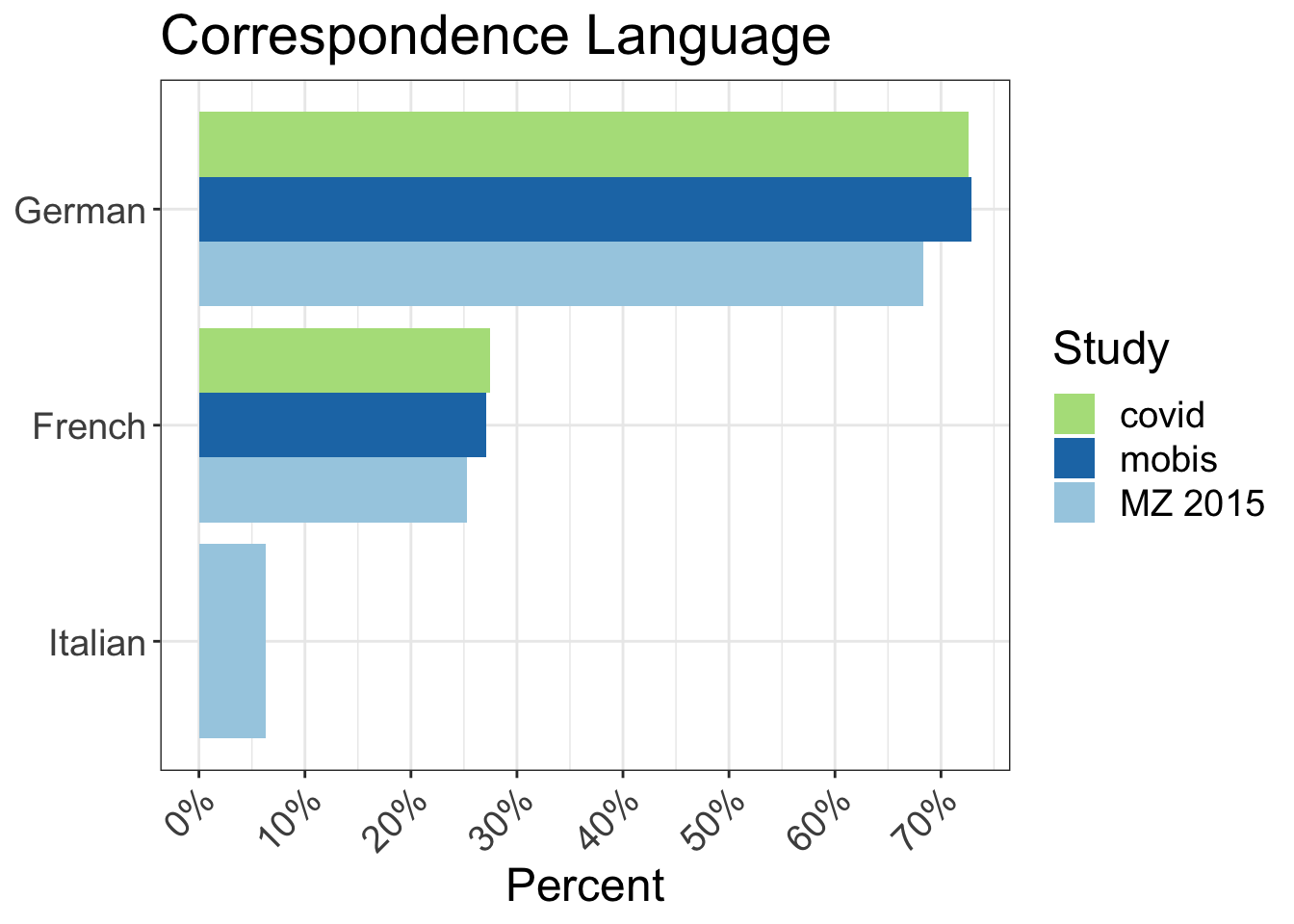
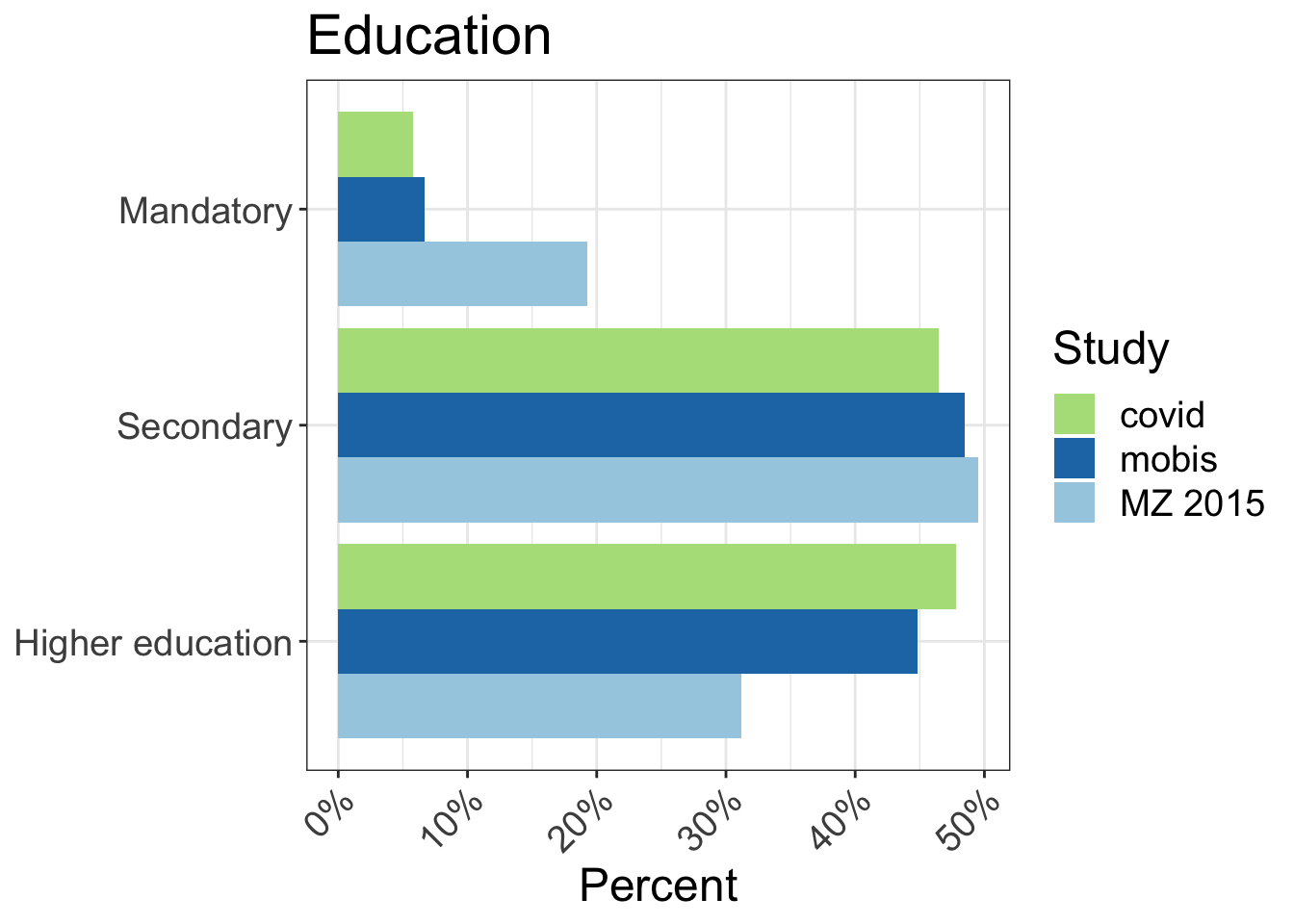
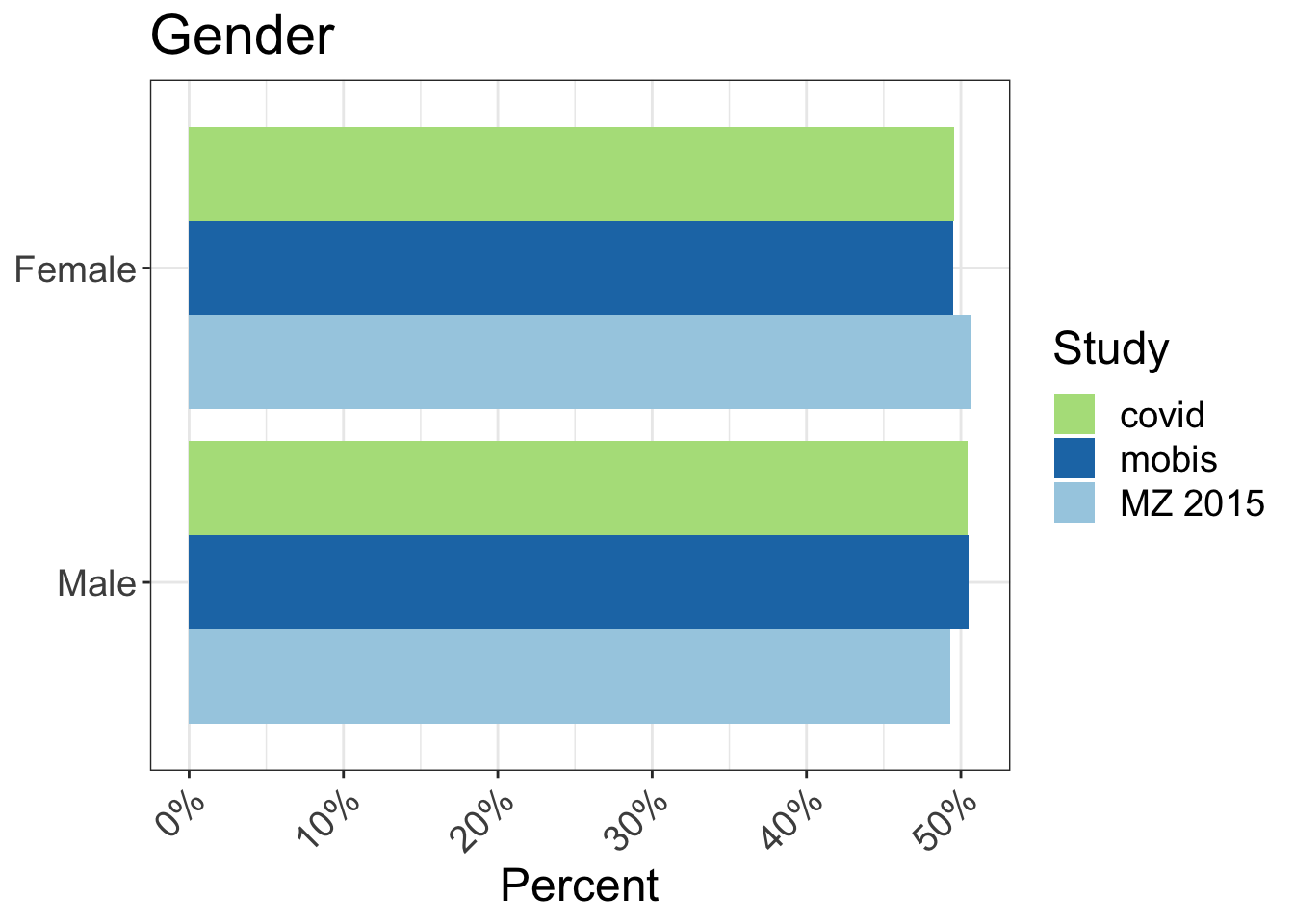
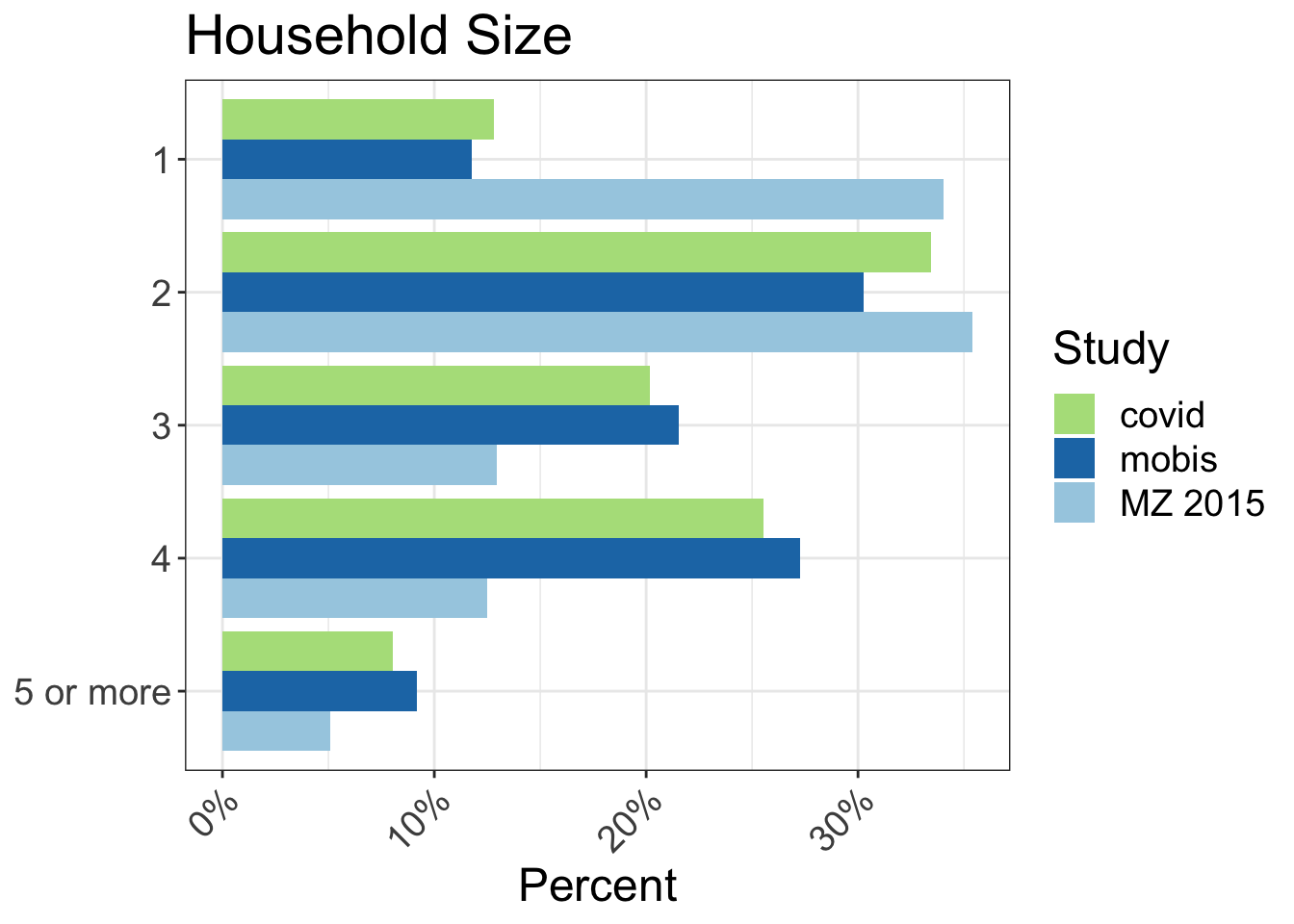
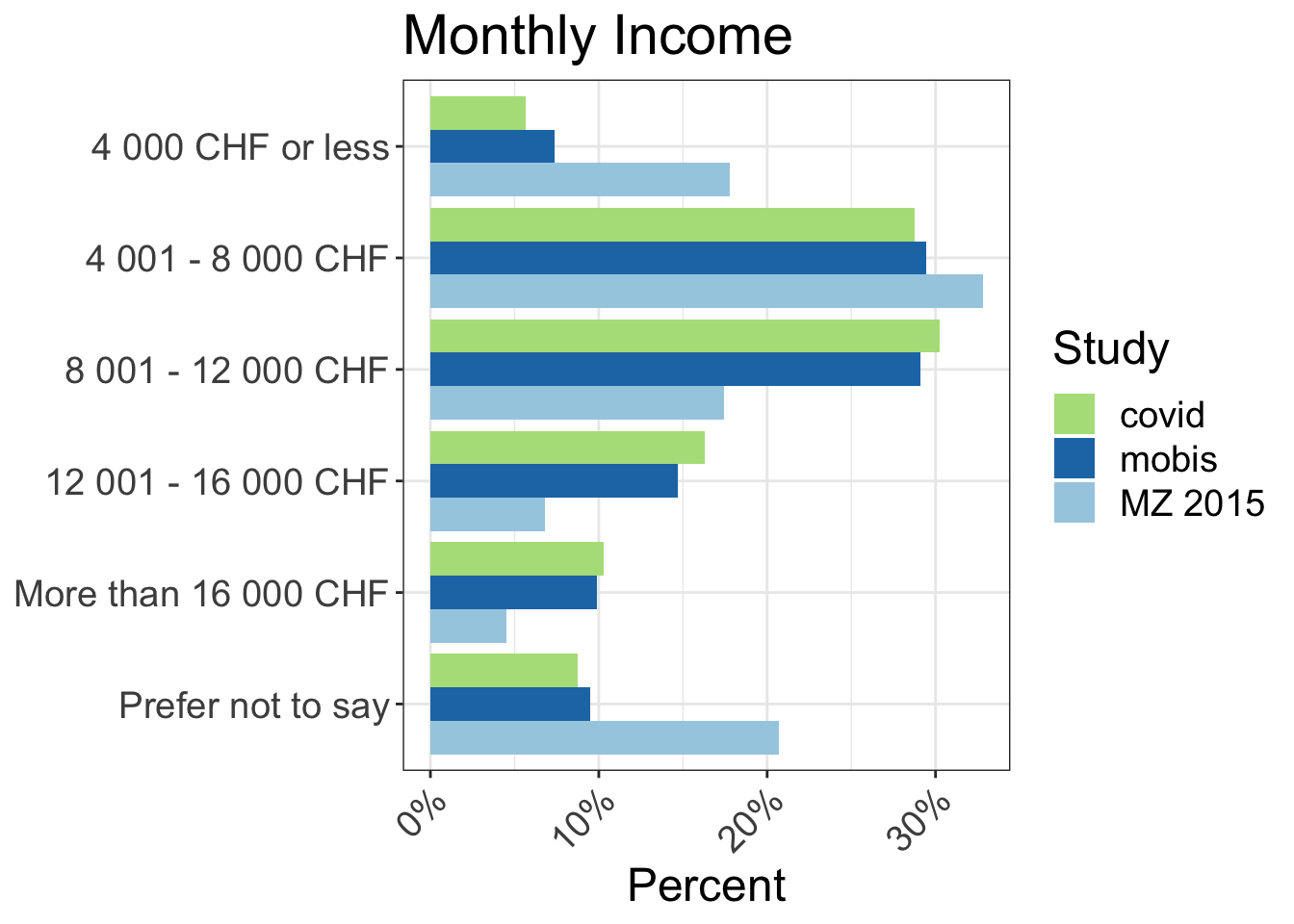
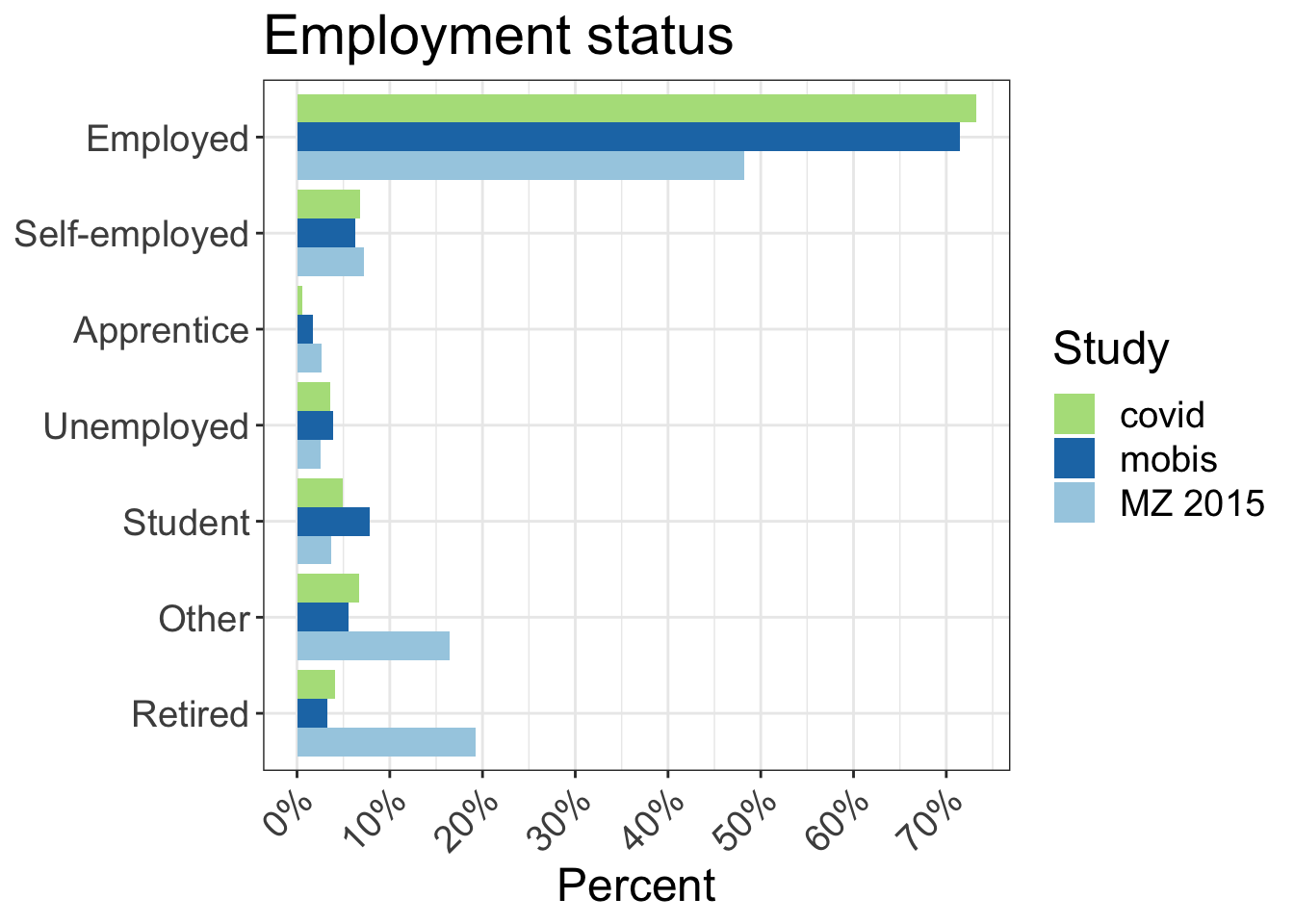
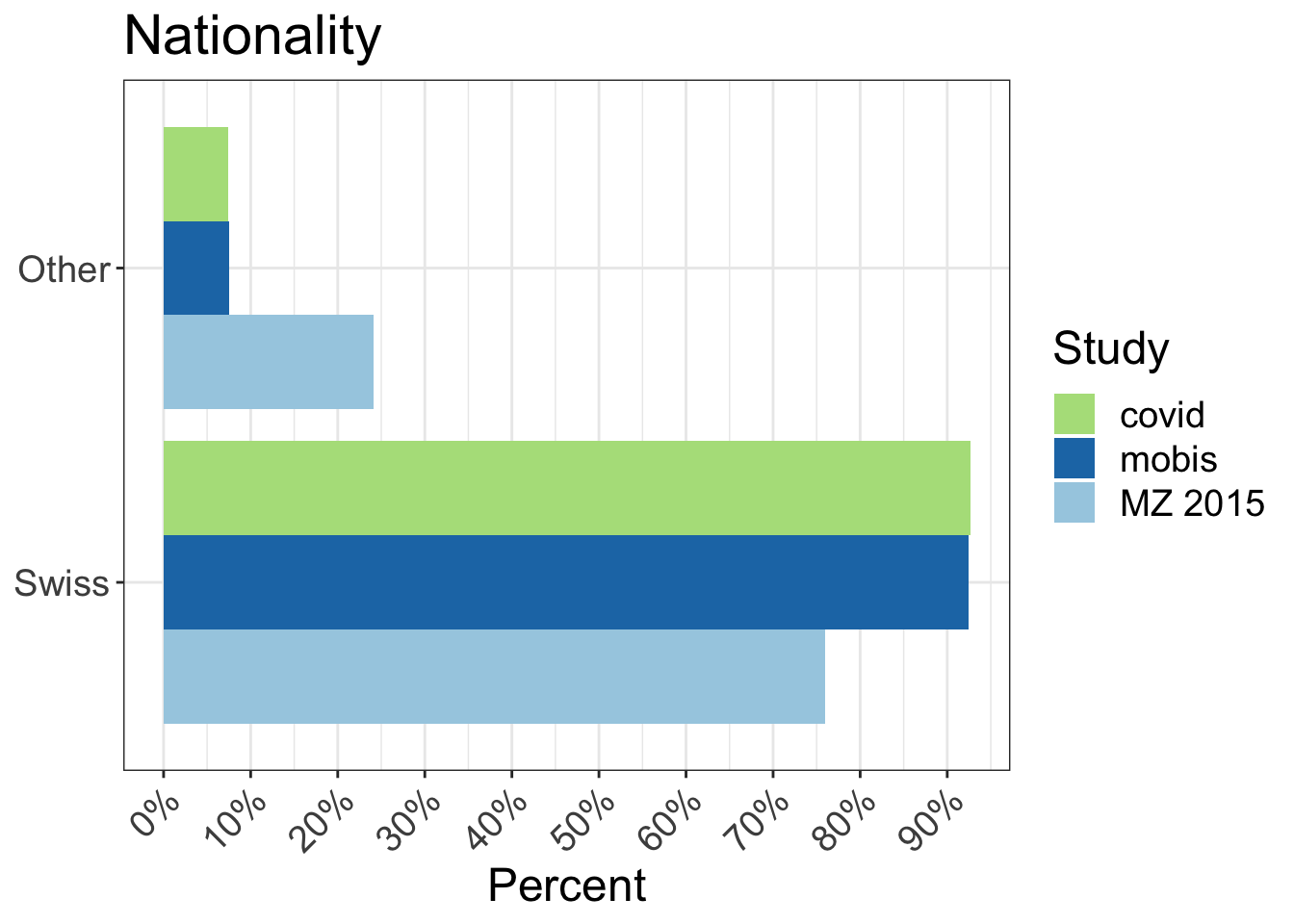
| Covid | MZ | Covid | MZ | |
|---|---|---|---|---|
| Aargau | 81 | 4,325 | 5.0 | 7.6 |
| Basel-Landschaft | 186 | 1,940 | 11.4 | 3.4 |
| Basel-Stadt | 39 | 1,555 | 2.4 | 2.7 |
| Bern | 190 | 7,244 | 11.7 | 12.7 |
| Fribourg | 8 | 1,942 | 0.5 | 3.4 |
| Geneva | 128 | 3,062 | 7.9 | 5.4 |
| Schwyz | 17 | 1,005 | 1.0 | 1.8 |
| Solothurn | 17 | 1,813 | 1.0 | 3.2 |
| Vaud | 291 | 5,303 | 17.9 | 9.3 |
| Zurich | 666 | 10,410 | 41.0 | 18.2 |
| Other | 3 | 18,491 | 0.2 | 32.4 |